Bulletin – November 2003 Statement on Monetary Policy
Download the complete Statement 965KB
The economic situation has evolved rapidly over recent months, both in Australia and abroad. For the global economy, prospects for growth have improved considerably after a period of deterioration in the first half of the year. The early stages of this improvement were already apparent at the time of the August Statement on Monetary Policy, and subsequent information from most parts of the global economy indicates that conditions have strengthened further.
In the United States, the pick-up in growth that had been expected for the second half of the year is now underway. The national accounts recorded strong growth in the September quarter, and the prevailing conditions in the US seem favourable to continued recovery in a number of respects. Monetary and fiscal policy settings are highly expansionary; profits have picked up over the past six months; business inventories are at low levels, suggesting that production will need to accelerate to keep pace with demand; and surveys suggest that business confidence is rising. The labour market has been disappointing to date, but there have been some tentative signs of improvement recently, with a gradual decline in new jobless claims and an increase in non-farm employment in September. Taking all these things together, the prospects for the US economy, while not entirely free of risk, look better than for some time.
Recent data from other parts of the world have also been stronger over recent months, though less so in the euro area. In east Asia, the data available for the September quarter show a strong bounce-back in growth in a number of the smaller economies in the region, while China continues to grow at a rapid pace. In addition, the Japanese economy continues in a cyclical upswing, with an easing in the rate of price deflation and improvements in business confidence.
The generally positive run of economic data around the world has been reflected in a clear change in sentiment in financial markets since mid-year, as concerns that the global recovery would falter gave way to increasing confidence about the outlook. This is evident in several areas. First, bond yields and share prices have risen around the world. Second, commodity prices have firmed, and resource stocks have outperformed in global equity markets, despite the substantial rise in the exchange rates of the countries of domicile of these resource companies.
Third, market expectations of official interest rates have also been affected. In most countries, the short end of the yield curve implies a view that official interest rates are at their trough for the current cycle, and attention is now focused mainly on the question of when interest rates will begin to rise. In Australia, as well as reflecting the favourable overseas developments, financial markets have been influenced by the run of strong local economic data, with the result that markets had begun to anticipate some tightening of monetary policy ahead of the Board's November decision, though a rise in cash rates had only been fully priced for the December meeting.
Finally, currencies which traditionally have been favoured by investors in the upswing in the international business cycle have risen in value, the Australian dollar among them. This has brought the trade-weighted index to a level slightly higher than its mid-year peak – but in circumstances quite different to those which prevailed then. At that time, the rise was largely driven by expectations that other countries would cut interest rates further due to weak growth. More recently, the rise in the exchange rate has occurred against a background of strengthening economic conditions, both in Australia and abroad. In this environment a rising exchange rate is the normal pattern.
The improving international situation has been accompanied by a marked strengthening of the domestic economy since mid-year. Consumer spending in Australia has picked up over recent months, with strong growth being recorded in retail sales and in motor vehicle sales. Consumer confidence, after increasing earlier in the year, has in the past few months been close to historical highs. The buoyancy of consumer spending is being supported by rising household wealth, driven in large part by continuing increases in house prices.
In addition to the strength of consumer spending, the prospects are for continued strength in business investment. Businesses are reporting substantial improvements in business conditions and in confidence about the future. According to a range of surveys, business confidence has now risen to levels consistent with well-above-average growth of the economy, with profits, sales and employment all reported to have increased strongly in the past few months. The unemployment rate has declined in recent months, to levels last seen in the late 1980s.
The one area of the Australian economy not to share in this general strength to date has been the export sector, where performance has been held back by a number of factors including the weak global environment of the past couple of years, the drought, the downturn in international tourism earlier this year, and the recent appreciation of the exchange rate. However, there are signs that the trough in exports has now passed. Rural exports will start to recover from the end of 2003, while international tourist numbers have already bounced back after their sharp drop in the June quarter. The improving global situation should mean, during 2004, a more favourable climate for most types of exports.
Inflation in Australia over the year to the September quarter was 2.6 per cent. This was little changed from the June figure, but noticeably below the results earlier in the year. The main reason for the recent decline in inflation is the dampening effect from the exchange rate appreciation over the past two years. This has resulted in a sharp fall in import prices and a broader deceleration of the prices of traded goods in the CPI. In contrast, inflation in the domestically oriented sectors of the economy has continued at a higher rate, with the non-traded component of the CPI increasing by around 4 per cent over the latest year, reflecting ongoing growth in costs and strong domestic demand pressures.
In the short term, continued pass-through of lower import prices will reduce the overall inflation rate. Over the longer term, inflation can be expected to be driven more by domestic pressures. The Bank's current assessment is that inflation could fall a little further than earlier expected over the next year, but pick up a little more after that, so that it will be about 2½ per cent by the second half of 2005. The balance of risks around this medium-term central forecast, however, seems now to be shifting to the upside. Businesses are already reporting greater-than-average difficulty in obtaining suitable labour. While overall wage costs remain contained at present, despite pressures in particular sectors, ongoing strength in demand would pose an increasing risk of acceleration of costs over time.
As has been clear in previous Statements, the Bank has judged the stance of monetary policy over the past several years to be expansionary when compared with relevant historical benchmarks. Both the cash rate and indicator rates of financial intermediaries have been at lower-than-average levels. It is clear, moreover, that borrowers in the private sector, and particularly households, have found it attractive to borrow at these rates of interest. The rate of growth of credit increased further in September, to be at an annual rate of 15 per cent over the latest six months; for credit to households, the corresponding figure is 22 per cent.
With the risks to the Australian economy from abroad abating further over recent months, and with signs that domestic growth was running faster than expected, the Board's deliberations turned to the question of how much longer such an expansionary stance of policy should be maintained. As discussed above, the outlook for inflation over the next year remains quite benign, due to the assumed effects of the higher exchange rate. But a rising exchange rate cannot be relied on to control inflation over the medium term; that requires domestic pressures to be properly contained. While at present those pressures appear manageable, over the medium term they are more likely to grow than to diminish in an economy growing faster than trend. In the mature stage of a long expansion, with less spare capacity than would have been the case some years ago, monetary policy needs to keep a close eye on future growth in demand.
A separate, but no less important issue, flagged repeatedly in previous Statements, is the rapid run-up in household debt. While this has been associated with a boost to domestic spending which was welcome in a weak international environment, such trends carry increasing risk if they persist over long periods. Those risks, discussed at length on other occasions and so not repeated here, appear to be growing. Monetary policy should, as far as possible, avoid adding to them.
Given all the above considerations, the Board judged at its November meeting that a firming in the stance of policy was appropriate, with the timing of such a change the main question. The Board took the view that the general macroeconomic case to move was quite clear, and that there was little to be gained by delaying action. Hence the cash rate was increased by 25 basis points in early November. Over the period ahead, the Board will continue to assess the changing balance of risks to the economic outlook and adjust the stance of policy as needed to foster sustained and balanced growth, consistent with achieving the inflation target over the medium term.
International Economic Developments
Global economic conditions have improved over recent months, with stronger economic data emerging in the US, Japan and most other countries in east Asia, though the euro area remains weak. Consistent with these developments, forecasts for world growth have been revised upwards recently, particularly for the US and Japan (Graph 1). This follows a succession of downward revisions to growth in the first half of the year. In its latest assessment of the international outlook, released in September, the IMF forecasts that growth in the G7 countries will accelerate from 1.8 per cent in 2003 to 2.8 per cent in 2004 and, for the world as a whole, from 3.2 per cent to 4.1 per cent (Table 1). The latest private-sector Consensus forecasts, released in October, are slightly stronger than those of the IMF, reflecting the more recent positive news out of the US and Asia.
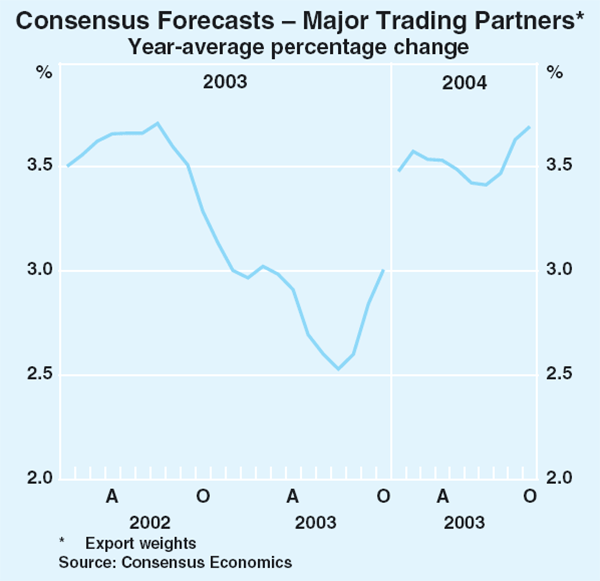
| 2001 | 2002 | 2003 | 2004 | |
|---|---|---|---|---|
| IMF forecasts (September 2003) | ||||
| United States | 0.3 | 2.4 | 2.6 | 3.9 |
| Euro area | 1.6 | 0.8 | 0.5 | 1.9 |
| Japan | 0.4 | 0.2 | 2.0 | 1.4 |
| China | 7.3 | 8.0 | 7.5 | 7.5 |
| Other Asia(a) | 1.1 | 4.4 | 2.8 | 4.2 |
| G7(b) | 0.8 | 1.6 | 1.8 | 2.8 |
| World(b) | 2.3 | 3.0 | 3.2 | 4.1 |
|
(a) GDP weights Source: IMF |
||||
United States
The pace of growth in the US has picked up over recent months, assisted by very expansionary macroeconomic policy settings and supportive financial conditions. In the September quarter, GDP increased by 1.7 per cent to be 3.3 per cent higher over the year (Graph 2, Table 2). While there is some uncertainty regarding the durability of the pick-up in growth, prospects look to be more positive than they have been for some time. In particular, the most recent data suggest that the headwinds that have retarded investment and employment growth over recent years may finally be dissipating.
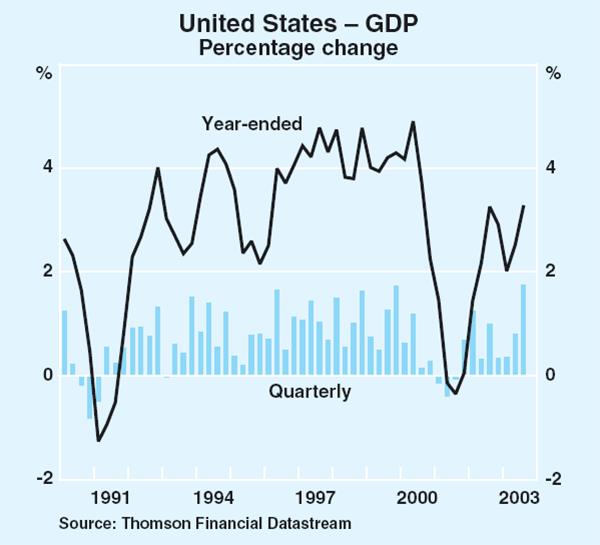
| June quarter 2003 |
September quarter 2003 |
Year to September 2003 |
|
|---|---|---|---|
| Private consumption | 0.9 | 1.6 | 3.5 |
| Residential investment | 1.6 | 4.8 | 11.5 |
| Business investment | 1.8 | 2.7 | 3.9 |
| Public expenditure | 2.1 | 0.3 | 3.7 |
| Change in inventories(a) | −0.2 | −0.2 | −0.6 |
| Net exports(a) | −0.4 | 0.2 | −0.4 |
| – Exports | −0.2 | 2.3 | 0.1 |
| – Imports | 2.1 | 0.0 | 2.3 |
| GDP | 0.8 | 1.7 | 3.3 |
|
(a) Contribution to GDP growth Source: Thomson Financial Datastream |
|||
The recent step-up in growth has been underpinned by strong household consumption, which rose by 1.6 per cent in the September quarter, propelled by a sharp increase in disposable income flowing from recent fiscal initiatives. These initiatives, which include a lowering of marginal tax rates and an increase in the child care tax credit, should provide a further similar-sized boost to household income in the first half of 2004 when tax refunds are paid. Much of the strength in consumption has been concentrated in durable goods, consistent with robust residential investment. Also supporting household spending has been the growth in house prices over the past year or so which, combined with more recent increases in equity prices, has resulted in a solid rise in household wealth.
While the labour market remains weak, there are tentative signs that the stronger economic growth is beginning to have some impact. The payrolls measure of employment rose in September for the first time in eight months, while the alternative household survey measure of employment is slightly higher than a year ago. The unemployment rate has edged lower over the past few months to 6.1 per cent in September, and other indicators, such as new claims for unemployment benefits, are also showing signs of stronger labour demand. With production having run ahead of employment, it is likely that increased labour hiring will soon be required to facilitate the continued solid expansion of production.
The more positive signals about the labour market are also consistent with higher business confidence in recent months. Non-manufacturing businesses are reporting highly favourable trading conditions, while conditions in the manufacturing industry have also improved with both production and durable goods orders showing an upward trend. Also, given low inventory levels, it seems probable that increased demand will soon have to be met by higher production. Financial markets have responded to these developments, with the stock market well up from its recent trough in March.
Improved conditions in the business sector, including rising profitability and a more favourable environment for external funding, are spurring higher investment spending (Graph 3). Business investment expanded by 2.7 per cent in the September quarter, marking the second consecutive quarterly increase after a protracted period of decline. A further rise in spending on computer equipment and software drove rapid growth in equipment investment in the September quarter, which is now 6.0 per cent higher than a year ago, while structures investment fell slightly in the quarter.
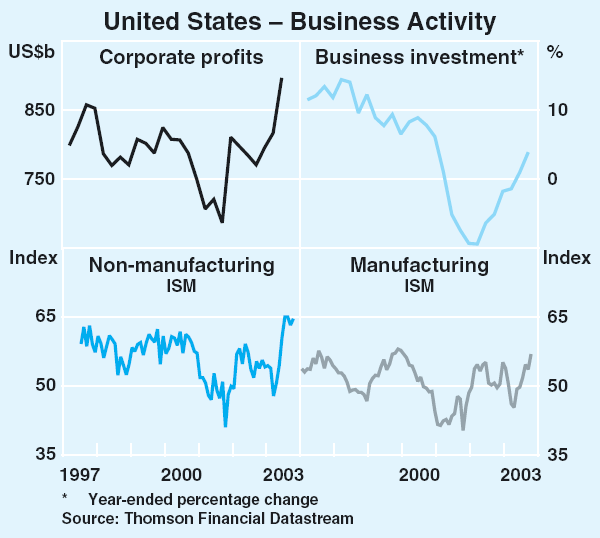
Consumer price inflation edged up to 2.3 per cent over the year to September, largely reflecting higher energy costs; the core measure has eased further to a year-ended rate of 1.2 per cent. Overall, inflation remains low, owing to falling unit labour costs and subdued upstream price pressures. Given these disinflationary forces, the Fed has stated that monetary policy can remain accommodative for a ‘considerable period’.
Asia-Pacific
Japan
More convincing signs have emerged in recent months that a cyclical upswing is underway in Japan. Output expanded by 1.0 per cent in the June quarter, with growth in real GDP now running at 3.0 per cent over the year. After an extended period in which the economy contracted in nominal terms, nominal GDP also rose slightly over the year (Graph 4). More recently, in September, industrial production rose strongly and is now 2.1 per cent higher than a year ago.
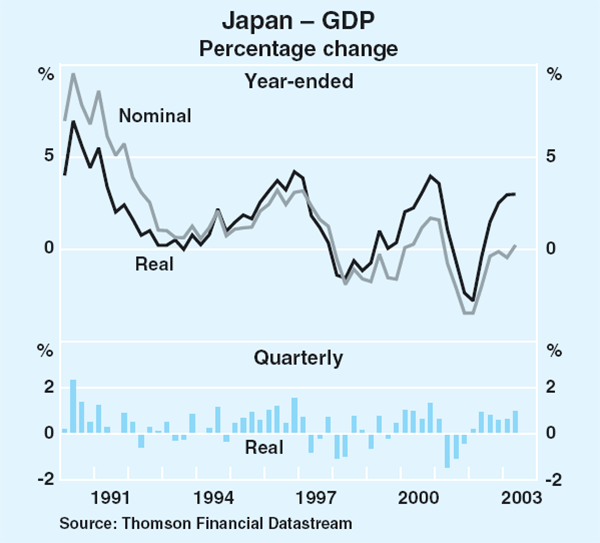
Aided by improved profitability, business investment has risen and machinery orders are well above levels of a year ago. To date, investment has been concentrated in the manufacturing sector, although in the September quarter Tankan survey, firms in non-manufacturing industries expressed positive investment intentions for the first time in five years. Exports have also shown healthy gains over the past year. Reflecting these positive developments, the Japanese stock market has risen by around 40 per cent over the past six months and long-term bond yields have risen by nearly 1 percentage point since the middle of the year.
While conditions in the services sector of the economy have remained subdued, the recovery in output growth has been associated with stabilisation of the labour market. Employment has been broadly unchanged over the past year, having fallen for much of the past six years, with the unemployment rate declining to 5.1 per cent by September – its lowest level in two years. The rate of decline in wages also appears to have slowed.
Notwithstanding stronger growth, Japan continues to experience deflation. This is most evident in the GDP deflator, which is 2.7 per cent lower over the year to the June quarter. Other measures of prices, however, suggest that the pace of deflation has eased in recent months. For example, core consumer prices fell by 0.1 per cent over the year to September, compared with deflation rates of around 1.0 per cent in the past few years, though an administered increase in medical costs and a rise in tobacco taxes account for some of the slowing in the rate of deflation.
While the current cyclical upswing will help to alleviate deflationary pressures in the short term, there remain ongoing structural concerns for the Japanese economy. The outstanding stock of non-performing loans remains high and bank lending continues to fall and is currently around 5 per cent lower than a year ago.
East Asia
China continues to grow at a remarkably strong pace, with output increasing by 9.1 per cent over the year to the September quarter. With imports increasing by 40 per cent over the past year, and exports expanding only slightly less rapidly, the current pace of growth in China is providing impetus to activity in the region.
Activity in other parts of east Asia is bouncing back from the effects of SARS, which saw a sharp slump in tourist arrivals and undermined domestic spending with the result that output fell in many economies in the June quarter. This followed an already weak performance in the March quarter, due to subdued external demand and domestic-led weakness in Korea. By early July, however, the SARS outbreak had been contained and activity in the affected economies has rebounded in the September quarter; the initial estimate for Singapore shows GDP rising by around 3.6 per cent in the quarter to be 1.0 per cent higher over the year. International arrivals to the countries most affected by SARS have almost fully recovered and arrivals to the rest of the region have also risen, though remain below levels in much of 2002 (Graph 5). Industrial production and exports have increased strongly in the region, after weakening in the June quarter (Graph 6).
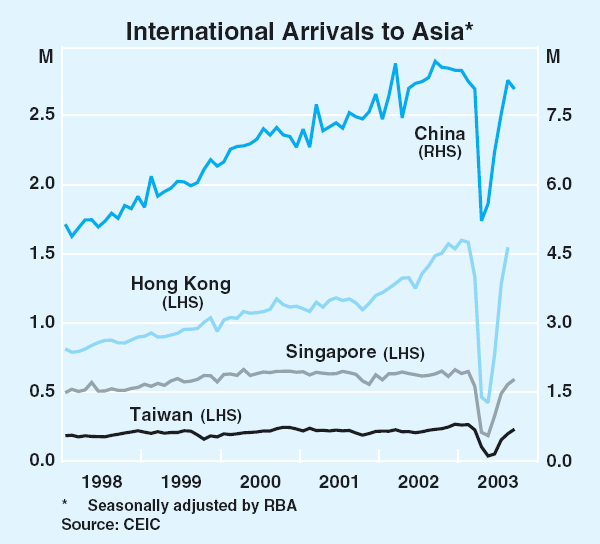
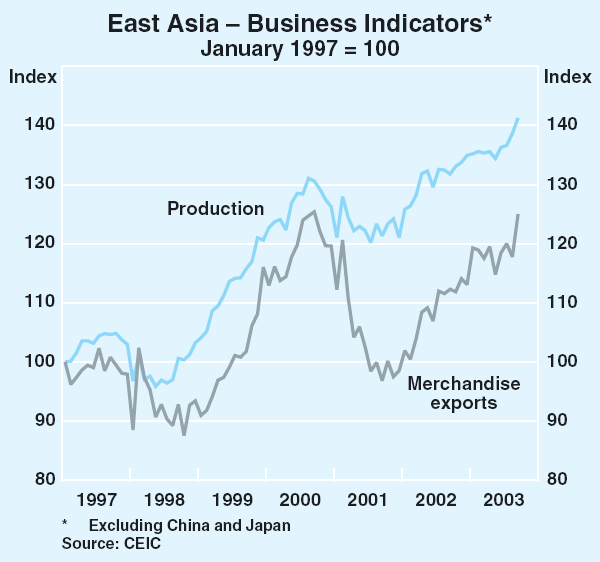
Along with the pick-up in activity, there are tentative signs that conditions are improving in labour markets across the region, with the unemployment rate declining slightly in a number of countries. These developments are yet to have much effect on consumer prices, with inflation remaining subdued in most countries.
As in Australia, domestic demand in New Zealand continues to grow at a strong pace while external demand remains quite weak. In the June quarter, GDP grew by 0.2 per cent to be 2.7 per cent higher over the year. Reflecting strength in much of the domestic economy, the unemployment rate continues to hover around record lows. This is placing some upward pressure on domestically sourced inflation, with the non-tradables component of the CPI rising by 4.1 per cent over the past year. House prices are also rising quickly, with the national measure climbing by 14 per cent over the year to the June quarter. Overall CPI inflation, however, remains at the lower end of the Reserve Bank of New Zealand's 1–3 per cent target band, with the currency appreciation exerting a dampening influence.
Europe
In contrast to the recovery in most major regions of the world, the euro area remains conspicuously weak, although some recent developments suggest that a modest improvement is in prospect. GDP was flat in the March quarter, and contracted slightly in the June quarter to be only 0.2 per cent higher over the year (Table 3). Exports fell, weighed down by lacklustre external demand and the earlier appreciation of the euro, and consumption growth slowed. This weakness in euro area activity reflects falls in output in the three largest economies in the region. The weakest performer, though, has been the Netherlands where household consumption has fallen, hampered by low consumer confidence and the adjustment of household balance sheets after a decade of heavy borrowing (Graph 7).
| March quarter 2003 |
June quarter 2003 |
Year to June 2003 |
|
|---|---|---|---|
| Euro area | 0.0 | −0.1 | 0.2 |
| – Germany | −0.2 | −0.1 | −0.2 |
| – France | 0.1 | −0.3 | −0.3 |
| – Italy | −0.1 | −0.1 | 0.3 |
| – Spain | 0.5 | 0.7 | 2.3 |
| – Netherlands | −0.3 | −0.6 | −1.2 |
| United Kingdom | 0.2 | 0.6 | 2.0 |
|
Source: Thomson Financial Datastream |
|||
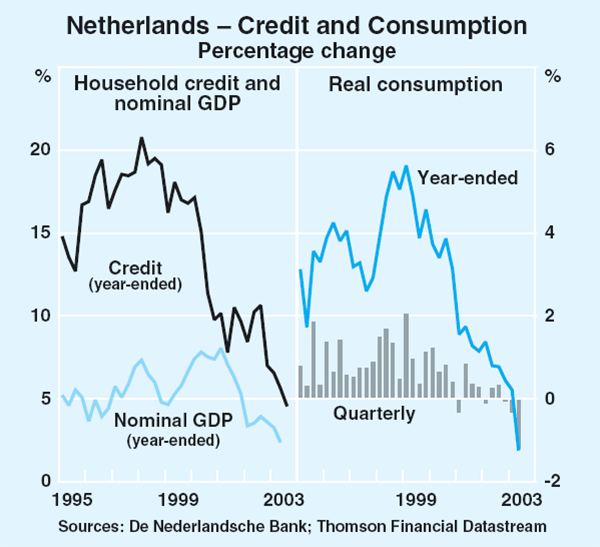
Despite these poor outcomes in the first half of the year, there are some tentative signs that a modest recovery in the euro area may be underway. Industrial production and exports have risen in recent months and most measures of business confidence are considerably firmer than earlier in the year (Graph 8). There is yet, however, no firm evidence of a recovery in household demand, which remains sluggish even though consumer confidence has edged up from its recent lows. The unemployment rate for the euro area as a whole has risen from 8.0 per cent in late 2001 to 8.8 per cent currently.
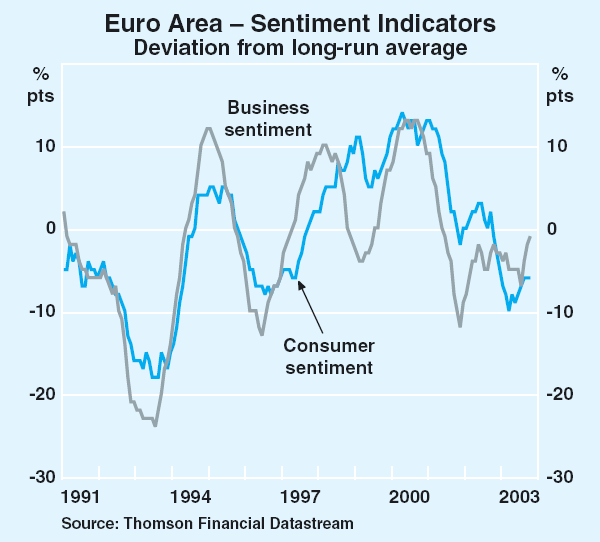
Consumer price inflation in the euro area increased to 2.1 per cent over the year to October, primarily due to higher food and energy prices; the core measure of inflation is lower at 1.7 per cent (Graph 9). The ECB has kept its policy rate unchanged since June, noting that the downside risks to economic growth had declined, but not ‘disappeared’. Furthermore, fiscal deficits have expanded considerably in recent years, with both Germany and France expected to post deficits exceeding 4 per cent of GDP this year, remaining well above the 3 per cent ceiling of the Stability and Growth Pact in both 2004 and 2005.
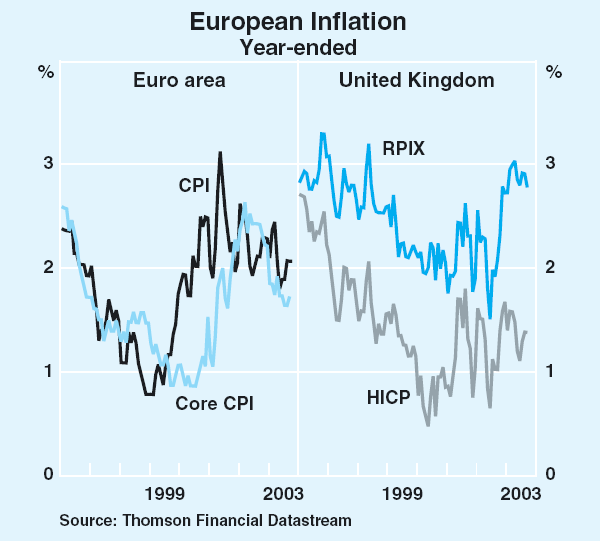
Growth in the UK has been picking up since the middle of the year, with this recovery now clearly evident in revised national accounts data. GDP grew by 0.6 per cent in the September quarter to be 1.9 per cent higher over the year. Household spending continues to grow solidly, supported by a relatively tight labour market, with the unemployment rate remaining at historically low levels. As in Australia, consumption has also been supported by rapid house price inflation, with prices rising by 16 per cent over the past year and doubling over the past five years. This has encouraged housing equity withdrawal, which amounted to 6 per cent of household disposable income in the June quarter (Graph 10). Retail price inflation in the UK continues to hold slightly above the Bank of England's 2.5 per cent target, coming in at 2.8 per cent over the year to September.
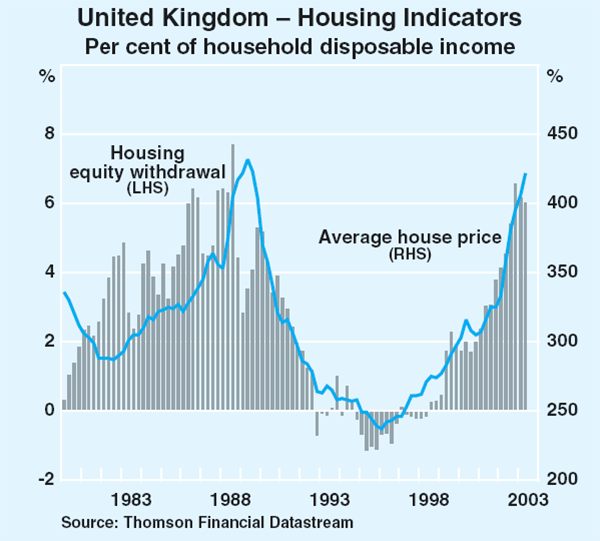
International and Foreign Exchange Markets
Sentiment in financial markets has continued to improve over the past three months, with bond yields in most major markets rising and equity markets rallying further. The mood in markets has keyed off growing evidence that a solid upswing in economic activity is underway in the US and Asia, and to a much smaller extent in Europe.
There have been no significant changes to monetary policy among overseas countries in the past three months although financial markets are suggesting that the next move in monetary policy in these countries is likely to be a tightening. This is seen as some way off in the larger countries, though perhaps imminent in some other developed economies.
Foreign exchange markets have been quite volatile over recent months, particularly around the September G7 meeting in Dubai when finance ministers issued a statement arguing that more flexibility in exchange rates was desirable. This was viewed by the market as a further softening in the ‘strong dollar’ stance of the US, as well as being directed at the Asian countries, particularly China and Japan, which had been intervening heavily to prevent their currencies rising against the US dollar. The US dollar has weakened significantly further on a trade-weighted basis. This has been one reason why the Australian dollar has risen substantially against the US dollar while being only modestly higher against most other G10 currencies and little changed against the Japanese yen.
Money and bond yields
The monetary policy easing cycle that involved many developed country central banks from mid 2002 to mid 2003 now appears to have largely run its course (Table 4).
| Cumulative reductions in down cycle Basis points |
Changes in policy rates Basis points | Current level Per cent | ||
|---|---|---|---|---|
| Jan–July 2003 | Since July 2003 | |||
| US | −550 | −25 | – | 1.00 |
| Canada | −375 | +25 | −25 | 2.75 |
| Switzerland | −325 | −50 | – | 0.25 |
| UK | −250 | −50 | – | 3.50 |
| Australia | −200 | – | +25 | 5.00 |
| NZ | −175 | −75 | – | 5.00 |
| Euro area | −275 | −75 | – | 2.00 |
| Sweden | −150 | −100 | – | 2.75 |
| Japan | −25 | – | – | 0.00 |
|
Source: Central banks |
||||
The monetary authorities of the US and Japan have reiterated that monetary policy will remain accommodative for the foreseeable future as the excess capacity that has built up as a result of the earlier period of economic weakness is seen as limiting inflationary pressures for some time. As such, futures markets reflect no expectation of a policy change in these countries in the near future. The ECB has been less explicit, though the recovery in economic activity in the euro area has been somewhat weaker than in the US and Japan. Accordingly, while futures markets are suggesting that the next move from ECB will be a tightening in monetary policy, it is not priced in until mid 2004.
In the UK, however, markets see a high probability of an early tightening. These expectations were given further force when minutes of the Bank of England's Monetary Policy Committee showed that it had voted only narrowly against raising policy rates at its October meeting. Expectations of monetary tightening in New Zealand also increased after the Reserve Bank of New Zealand's October policy statement.
Among Asian emerging markets, Indonesia was the only country to lower official rates. Monetary policy in most other Asian countries remained stable after a series of SARS-related easings in the first half of the year. The one exception was China where the central bank increased its required reserve ratio for commercial banks by 1 percentage point to 7 per cent, in an effort to curb rapid growth in credit. Brazil continued to lower rates towards more accommodative levels, as inflation abated and the real stabilised.
Bond yields in the major markets have risen substantially since mid year, when significant downside risks to world economic growth were seen by markets (Graph 11). In the US, 10-year bond yields are currently 4.4 per cent, around 120 basis points above the mid-June trough, reflecting the run of positive economic data in recent months. Selling of Treasury securities by holders of mortgage-related debt, in order to hedge their increasing interest-rate risk, remained a factor exerting upward pressure on yields. Working in the other direction, the investment of the US dollar proceeds of foreign exchange intervention by Asian central banks was supportive of the US Treasury market, as was the very wide spread between 10-year Treasury yields and the Fed funds rate, particularly in light of the Fed's reaffirmation of its intention to maintain an accommodative monetary policy stance (Table 5, Graph 12).
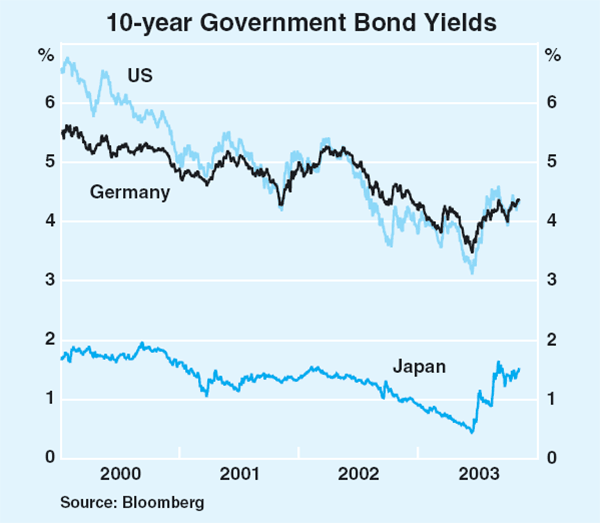
| Change in Asian foreign exchange reserves |
Change in US federal debt outstanding(a) |
|
|---|---|---|
| 2001 I | 11 | −134 |
| 2001 II | 97 | 128 |
| 2002 I | 126 | 72 |
| 2002 II | 96 | 186 |
| 2003 I | 172 | 170 |
| 2003 II to date | 127 | 113 |
|
(a) Excludes holdings of federal agencies, except for 2003 II to date Sources: IMF, US Federal Reserve, US Treasury |
||
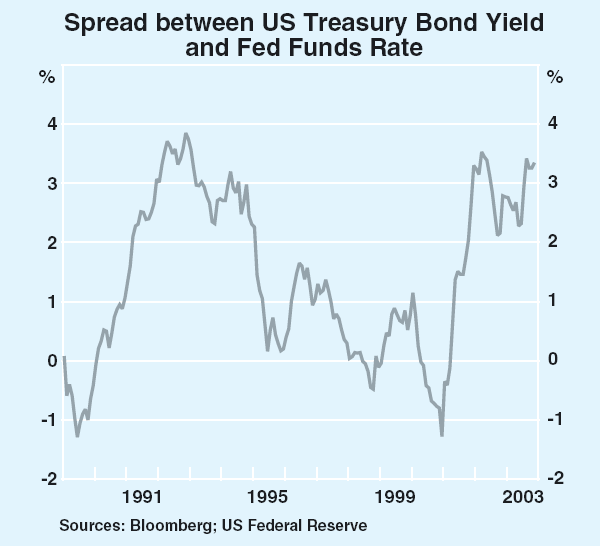
Bond yields in Europe have increased by around 90 basis points since the middle of the year. This is less than the rise in US yields as economic data in the euro area have not shown the same improvement as in the US. Bond yields in Japan have increased by about 110 basis points since mid year, to 1.5 per cent.
Reflecting the ongoing improvement in investor sentiment and appetite for risk in global debt markets, corporate spreads have continued to fall over recent months. In the US, spreads are currently at levels well below those seen prior to the high-profile corporate collapses in 2002 (Graph 13). With spreads narrowing across the board, most corporate bond yields are below where they were at the beginning of the year and, in the case of lower-rated corporate bonds, are around their mid-June lows.
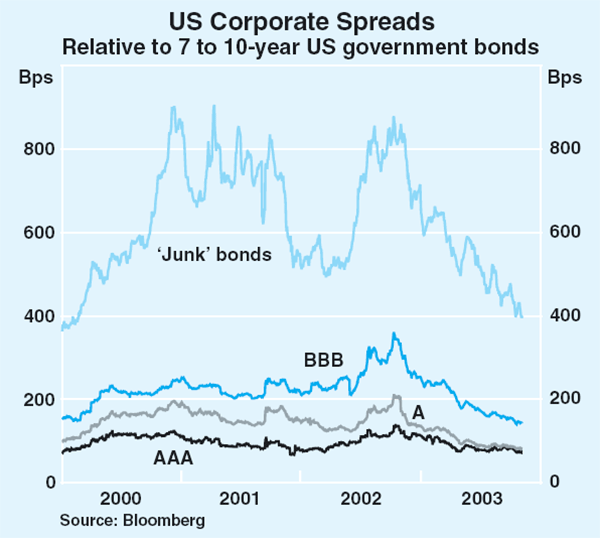
Spreads between emerging market sovereign debt and US Treasuries have also narrowed further over the past three months (Graph 14). This occurred despite a threatened default by Argentina when it missed a loan repayment to the IMF on 9 September. The payment was made a couple of days later, following provisional agreement on a new accord with the IMF to roll over US$12.5 billion in debt over three years as part of a revised programme for the country. In the same month, Argentina foreshadowed a restructuring offer that would return US25 cents in the dollar on the debt on which it had defaulted in 2001.
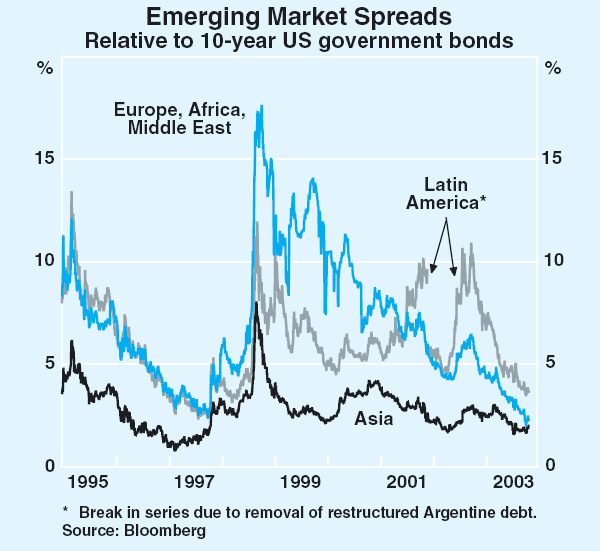
The general reduction in risk aversion has been complemented by a number of sovereign ratings upgrades. In the case of Asia, credit ratings for those countries hardest hit by the financial crisis of the late 1990s still remain below the ratings recorded immediately prior to the crisis (Table 6). The latest credit rating upgrade for Russia, however, means that its debt is now rated more highly than it was prior to the Russian debt crisis in 1998.
| End 1996 | Subsequent low | Current | |
|---|---|---|---|
| Asia | |||
| – China | BBB | BBB | BBB |
| – Hong Kong | A | A | A+ |
| – Indonesia | BBB | D | B |
| – Korea | AA− | B+ | A− |
| – Malaysia | A+ | BBB− | A− |
| – Philippines | BB | BB | BB |
| – Singapore | AAA | AAA | AAA |
| – Taiwan | AA+ | AA− | AA− |
| – Thailand | A | BBB− | BBB |
| Other | |||
| – Argentina | BB− | D | D |
| – Brazil | B+ | B+ | B+ |
| – Turkey | B | B− | B+ |
| – Russia | BB− | D | BB |
|
Source: Standard & Poor's |
|||
Equity markets
Like bond markets, equity markets have also responded to increasing optimism about the prospects for a global recovery, with the major markets extending the strong upward move that began in March. In the US, the S&P 500 has recovered by 31 per cent from its trough in March; the technology-focused NASDAQ has increased by 54 per cent over the same period, reflecting signs that the IT industry is recovering more rapidly than other sectors (Table 7).
| Since 2000 peak |
Over 2001 | Over 2002 | 2003 to date |
Since 2003 trough |
|
|---|---|---|---|---|---|
| United States | |||||
| – Wilshire | −30 | −12 | −22 | 23 | 35 |
| – Dow Jones | −16 | −7 | −17 | 18 | 30 |
| – S&P 500 | −31 | −13 | −23 | 20 | 31 |
| – NASDAQ | −61 | −21 | −32 | 47 | 54 |
| Euro area | |||||
| – STOXX | −50 | −20 | −35 | 13 | 41 |
| United Kingdom | |||||
| – FTSE | −38 | −16 | −24 | 9 | 31 |
| Japan | |||||
| – TOPIX | −39 | −20 | −18 | 26 | 38 |
| Canada | |||||
| – TSE 300 | −31 | −14 | −14 | 19 | 26 |
|
Source: Bloomberg |
|||||
The latest earnings guidance from US corporations presents a generally positive picture with both the ‘as reported’ and ‘operating’ measures of earnings improving in the September quarter. Nonetheless, in the case of a number of well-established US corporates, investors remain concerned about the extent of unfunded medical and pension liabilities and the equity prices of these firms have generally underperformed the overall market. In a couple of instances, such as US car manufacturers, these firms have experienced ratings downgrades or have been put under review for a possible downgrade. The S&P 500 price-earnings (P/E) ratio currently stands at around 30, well above its long-run average (Graph 15).
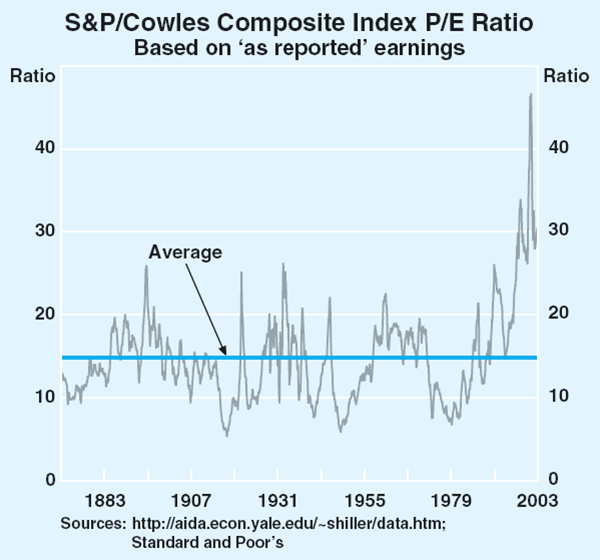
European equity prices have also continued to rise with the increases since the March low a little stronger than those in the US market (Graph 16). In Japan, share prices have risen by a similar magnitude, with markets pleasantly surprised by the strength of economic data in Japan in recent months.
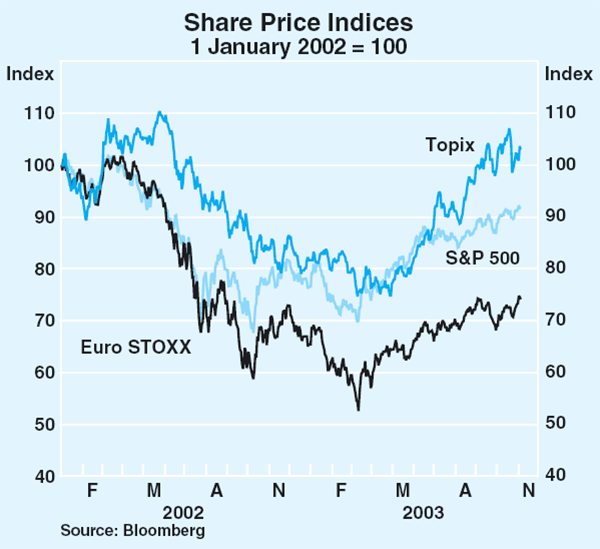
The improvement in the global economy has also flowed through to emerging market shares with both Asian and Latin American share prices rising appreciably over the same period. Russian equity prices weakened towards the end of October following the arrest of the chief executive of Russia's largest oil company and the freezing of some of its shares. Nonetheless, Russian equity prices are still more than 50 per cent higher than at the beginning of the year.
Exchange rates
In recent months, the US dollar has continued the decline that began in early 2002 (Graph 17). The fall accelerated after the mid-September release of a G7 Finance Ministers' statement which called for greater flexibility in exchange rates in the interests of promoting smooth and widespread adjustments in the international financial system. Markets interpreted this as a signal that the US authorities were no longer pursuing a ‘strong dollar’ policy – despite later statements to the contrary. The Japanese authorities slowed the very heavy intervention they had been undertaking in earlier months and the yen appreciated by as much as 8 per cent to 108 against the US dollar between end August and late October – its highest level for nearly three years – before weakening a little. The euro appreciated by 6 per cent against the US dollar over the same period and is now higher by 9 per cent this year.
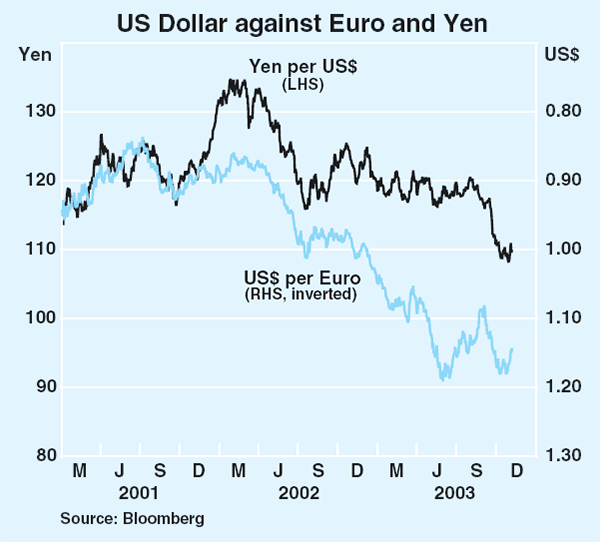
The currencies of most other developed countries have also appreciated substantially against the US dollar in recent months, as they have generally tended to move in line with the euro. However, most emerging market currencies, particularly those in Asia, have maintained a close relationship with the US dollar. As such the US broad TWI fell by only about half as much as the fall against the major currencies (Graph 18).
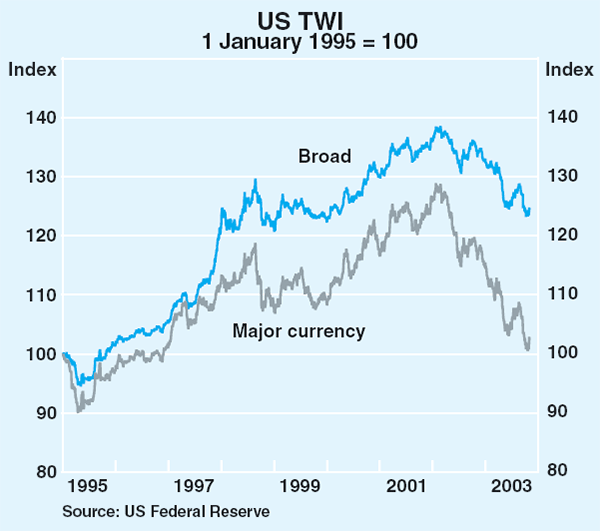
The linking of Asian currencies to the US dollar has caused some consternation in both the US and Europe with the G7 statement being viewed by the market as a veiled attack on the exchange rate policies of a number of Asian countries. Over recent years countries in Asia have been intervening heavily (buying US dollars and selling their own currencies) in order to prevent an appreciation of their currencies. This has resulted in very large increase in their holdings of reserve assets (Graph 19). The accumulation of reserves has been particularly noticeable in China and Japan, and to a lesser extent, in Korea and Taiwan (Graph 20). Other measures, such as exchange controls, are also being used to stem the appreciation of local currencies, with the authorities in Thailand announcing in October a package of measures, including suspension of interest payments to overseas holders of Thai cheque and savings accounts and a deposit ceiling of 300 million baht (US$7.5 million) per account.
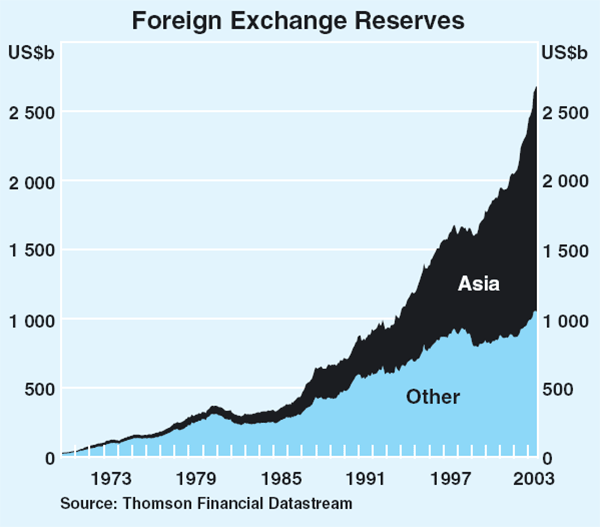
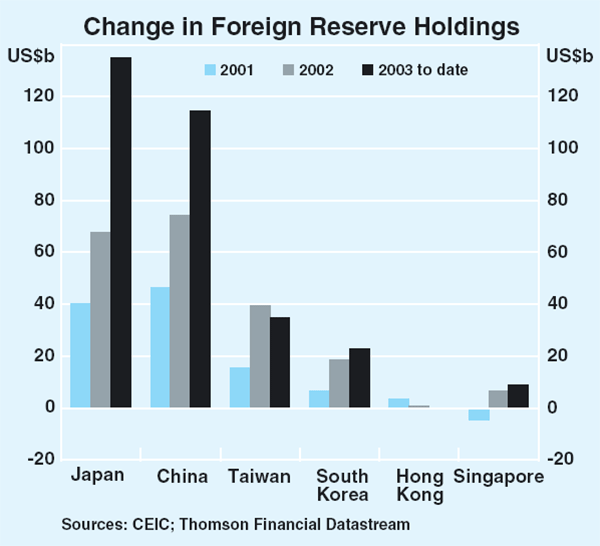
The focus on Asian currencies, and the renminbi in particular, has also reflected a steady increase in China's share of global export markets; over the past five years China's exports have increased by an average of 16 per cent per year. This means that China is now vying with Japan to be the third largest exporter globally, behind the United States and Germany (Graph 21). However, while China's exports are highly visible, its imports are also growing rapidly, meaning that it runs a relatively modest, and declining, trade surplus of around 2 per cent of GDP.
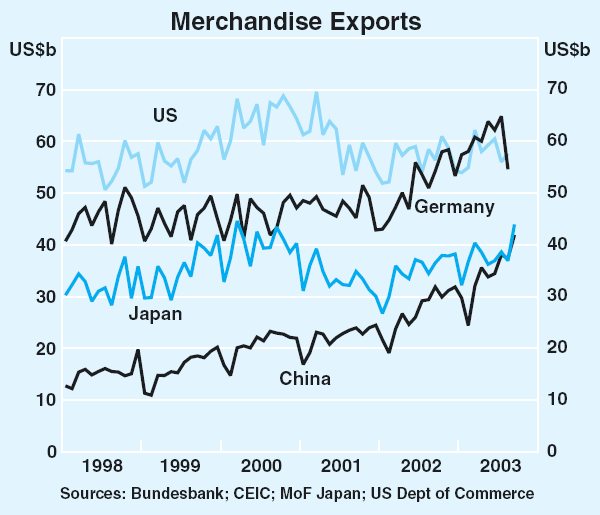
Australian dollar
The Australian dollar recorded another strong rise over the period since the previous Statement, particularly against the US dollar which was weakening on global markets (Graph 22). The local currency was up by 8 per cent against the US dollar and about 7 per cent against the euro but flat against the Japanese yen. Against other Asian currencies it was up by around 8 per cent, which was similar to the increase against the US dollar, given that these currencies have been largely moving with the US currency. Reflecting the significant weight Asian currencies have in the trade-weighted index of the Australian dollar, the index was up by 6 per cent over the period.
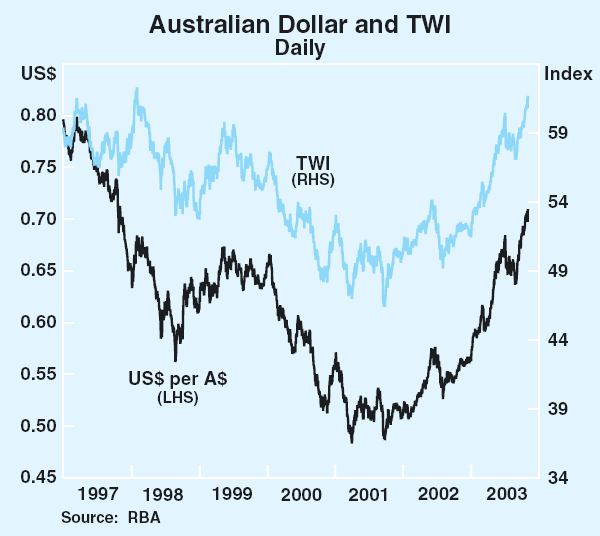
While the rise in the Australian dollar in recent weeks has been on a scale similar to that which took place in the second half of the June quarter, the circumstances driving it are very different. The June quarter rise was caused by very negative developments abroad, particularly concerns that other countries would lower interest rates much further in the face of weak economic activity. The latest rise, in contrast, reflects positive developments in the world economy and in Australia and is therefore more in keeping with current circumstances. The recent buying of the currency seems to have been underpinned by the strengthening in commodity prices, reflecting the sharp improvement in the market's view about world economic prospects. In other words, the market has gone back to a more traditional model of the Australian dollar, based on a commodity price story. Other currencies that have traditionally had a ‘commodity’ element (the Canadian dollar, NZ dollar and South African rand) have also risen strongly over the past couple of months. Demand for Australian dollars by Japanese retail investors through the A$ Uridashi bond market has eased back from the very high levels earlier in the year, though it remains significant (Graph 23).
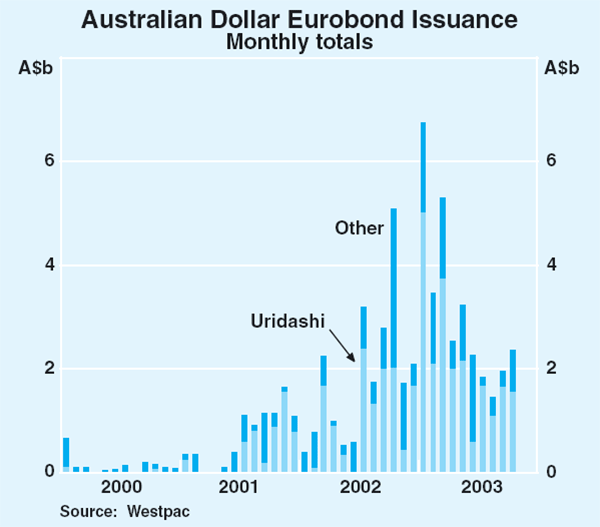
Resource company hedging levels, as recorded in the NAB quarterly business survey, have remained fairly steady this year at around 25–30 per cent of exposures (Table 8). The larger diversified resource companies tend not to be active in hedging their revenues, relying instead on the natural hedge achieved through having operations in a wide range of countries and exposure to a mix of commodities.
| Share of net exposure hedged Per cent | Average term Months | Average exchange rate US$ | |
|---|---|---|---|
| Jun 2001 | 24.2 | 24.0 | 0.5133 |
| Sep 2001 | 20.4 | 19.2 | 0.5141 |
| Dec 2001 | 23.2 | 37.3 | 0.5118 |
| Mar 2002 | 9.4 | 41.0 | 0.5182 |
| Jun 2002 | 9.4 | 6.0 | 0.5510 |
| Sep 2002 | 22.3 | 25.5 | 0.5479 |
| Dec 2002 | 38.5 | 27.9 | 0.5578 |
| Mar 2003 | 23.8 | 26.2 | 0.5927 |
| Jun 2003 | 29.4 | 31.5 | 0.6401 |
| Sep 2003 | 27.5 | 21.0 | 0.6584 |
|
Sources: NAB Quarterly Business Survey; RBA |
|||
Over the past year the Australian dollar is up by 26 per cent against the US dollar and about 10 per cent against the euro (Table 9). Gains against most other floating currencies have also been limited, though those against most Asian currencies have been similar to that against the US dollar. As noted, Asian currencies are important in the TWI and the appreciation against these currencies accounts for about two-thirds of the 18 per cent rise in the TWI over the past year.
| Over past year |
Since last Statement |
||
|---|---|---|---|
| Philippine peso | 32.1 | 9.2 | |
| US dollar | 26.4 | 8.4 | |
| Singapore dollar | 25.1 | 7.5 | |
| Taiwan dollar | 24.2 | 7.2 | |
| South Korean won | 22.9 | 8.8 | |
| Swiss franc | 18.2 | 8.9 | |
| UK pound | 17.9 | 3.8 | |
| Indonesian rupiah | 16.3 | 7.5 | |
| Japanese yen | 13.7 | 0.4 | |
| European euro | 10.4 | 7.0 | |
| Swedish krona | 9.1 | 5.0 | |
| Canadian dollar | 8.3 | 3.5 | |
| NZ dollar | 1.5 | 2.9 | |
| PNG kina | −1.2 | 6.3 | |
| South African rand | −11.7 | 1.6 | |
| TWI | 18.0 | 5.8 | |
|
Source: RBA |
|||
The Australian dollar in trade-weighted terms is currently about 7 per cent above its post-float average. However, this masks some divergent trends. Against the G10 currencies, the Australian dollar is still on average about 8 per cent below its post-float average (Graph 24). In contrast, against the currencies of non-Japan Asia the Australian dollar is about 35 per cent above its post-float average.
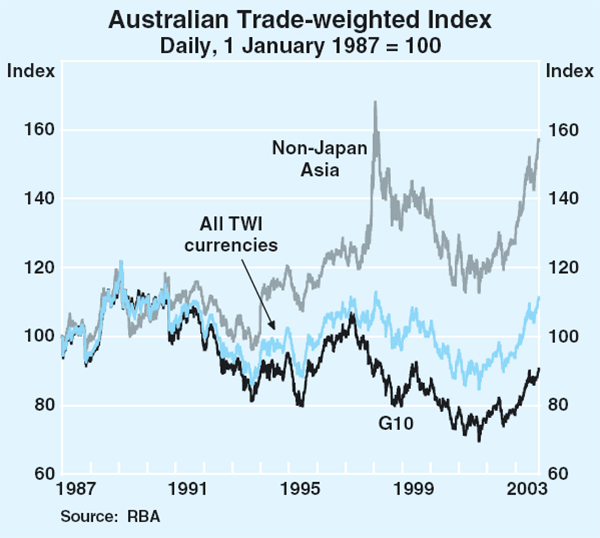
The RBA continued to rebuild its foreign currency reserves by making purchases in excess of the Government's requirements. In the three months to October, net purchases amounted to $2.0 billion, while earnings on reserves added another $40 million. The market value of net reserves at end October stood at $15.5 billion, up from $13.2 billion at the start of the financial year. The Bank also made substantial use of foreign exchange swaps during the past few months to manage domestic liquidity, though in net terms the swap position (at $30.1 billion) has not changed much since the start of the financial year. Total reserve holdings (i.e. reserves held outright plus reserves held under swap agreements) stood at $45.5 billion at end October.
Domestic Economic Conditions
Introduction
The pace of growth of the Australian economy has picked up since mid year. This improvement has been underpinned by a stronger international climate and improved conditions in the rural sector. Domestic demand growth has also shown signs of renewed strength. Both consumer and business confidence are at high levels and the outlook for business investment remains positive. Recent data on the housing sector have also been stronger than expected.
The impact of the weak world economy and the drought over the first half of 2003 are evident in the latest national accounts, which show that real GDP rose by 0.1 per cent in the June quarter and 2.0 per cent over the year (Table 10). This outcome reflects strongly contrasting performances of the domestic and external sectors. In particular, domestic demand grew by almost 5 per cent over the year to the June quarter, although the pace of growth slowed over the first half of 2003. In contrast, exports fell by around 5 per cent over the year, with net exports subtracting 3.5 percentage points from overall growth (Graph 25). The contrasting performance of different sectors of the economy is also evident in the fact that farm GDP fell by 32 per cent over the year to the June quarter, while non-farm GDP rose by 3.4 per cent.
| June quarter 2003 | Year to June quarter 2003 | |
|---|---|---|
| Private final demand(a) | 0.8 | 5.0 |
| – Consumption | 1.2 | 3.6 |
| – Dwelling investment | −4.1 | 4.1 |
| – Business investment(a) | 1.1 | 13.3 |
| Public final demand(a) | 2.6 | 3.8 |
| Domestic final demand | 1.2 | 4.7 |
| Change in inventories(b) | 0.2 | 1.0 |
| Exports | −4.7 | −4.8 |
| Imports | 2.2 | 11.1 |
| Net exports(b) | −1.5 | −3.5 |
| Gross domestic product | 0.1 | 2.0 |
| – Non-farm GDP | 0.3 | 3.4 |
| – Farm GDP | −5.7 | −32.1 |
|
(a) Excluding the effect of transfers between the private and other sectors
Source: ABS |
||
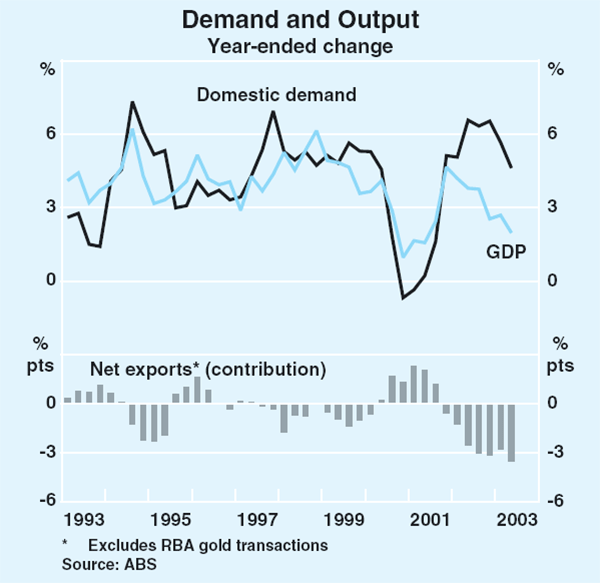
Looking forward, stronger and more balanced growth is expected. A recovery in exports appears to be underway and, as a result, net exports are expected to make a small positive contribution to growth over the coming year. Domestic demand is expected to continue to grow solidly, buoyed by strong growth in consumption. Indicators of investment intentions and of the amount of work in the pipeline suggest that growth in business investment should remain above its long-term average, and the outlook for dwelling investment now looks to be considerably stronger than was the case earlier in the year.
Household sector
Household consumption has grown solidly over the past year, with recent indicators suggesting considerable ongoing strength. Growth has been underpinned by a number of factors, including a high level of consumer confidence, a decline in the unemployment rate, favourable financial conditions and increases in wealth, fostered by rising housing prices.
In the June quarter, consumption rose by 1.2 per cent to be 3.6 per cent higher than a year earlier. Unlike the usual situation in which consumption of services grows more quickly than goods, the past few years have seen this pattern reverse (Graph 26). This is largely explained by two factors. The first is the very strong growth in purchases of motor vehicles, partly in response to a decline in prices. And the second is the high level of housing investment, which has contributed to rapid growth in purchases of housing-related items. Over the past two years, for example, expenditure on furnishings has increased by an average of 8 per cent per year, around twice the average rate of the past decade.
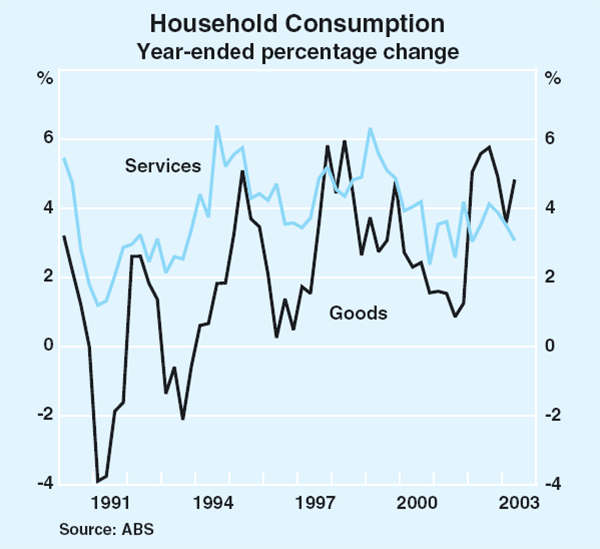
Recent indicators of consumption suggest that the strength in consumer spending seen earlier in the year has picked up over recent months. The volume of retail sales increased by 2.7 per cent in the September quarter, to be 5.4 per cent higher over the year, with sales of passenger vehicles also rising strongly in the quarter to be 14.1 per cent higher than a year earlier (Graph 27). The level of consumer confidence has also risen to its highest level in almost a decade.
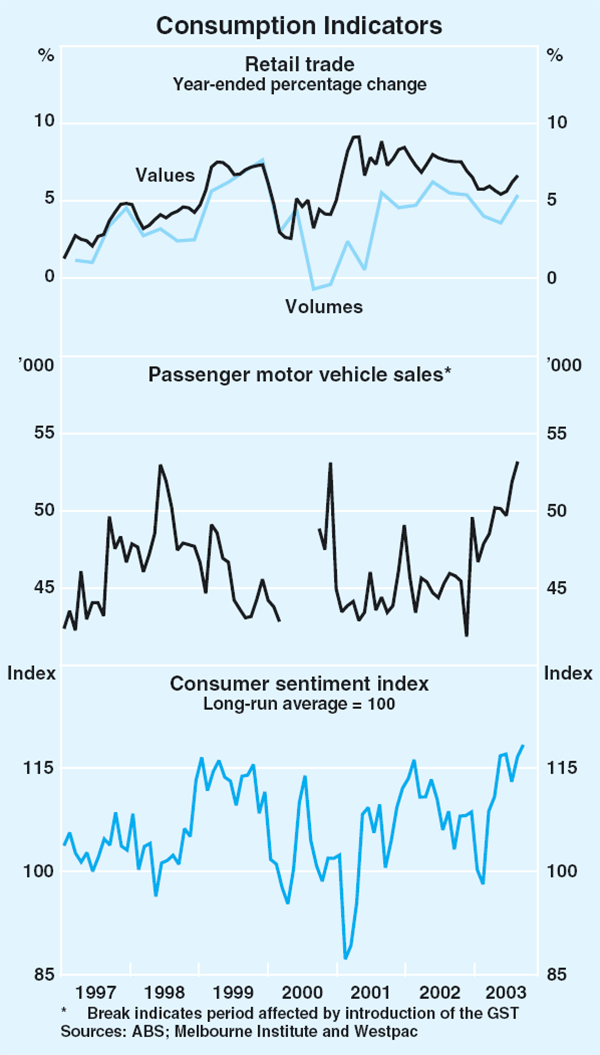
An important factor supporting consumption has been the strong gains in wealth arising mainly from higher house prices. Over the past year, the value of the household sector's assets have increased by around 17 per cent, bringing the cumulative increase over the past three years to 43 per cent. Partly because of these significant gains, consumption has risen faster than household disposable income over this period, and there has been a corresponding fall in the saving ratio. Over recent quarters, this fall has been compounded by the weakness in farm incomes.
While household assets are rising strongly, households continue to accumulate debt at a rapid pace. Household credit grew by 5½ per cent over the three months to September and by 21 per cent over the year. While most of this borrowing has been used to finance the acquisition of dwellings, including by investors, households have also increased their borrowing to finance consumption. This is evident in the strong growth in personal credit over the six months to September and the rapid pace of growth in revolving credit secured against residential mortgages. More broadly, the household sector continues to withdraw housing equity to finance non-housing activities. In the June quarter, the overall rise in housing-secured credit exceeded dwelling investment by the equivalent of 8 per cent of household disposable income, which is almost twice the average magnitude of housing equity withdrawal seen over the past two years (Graph 28).
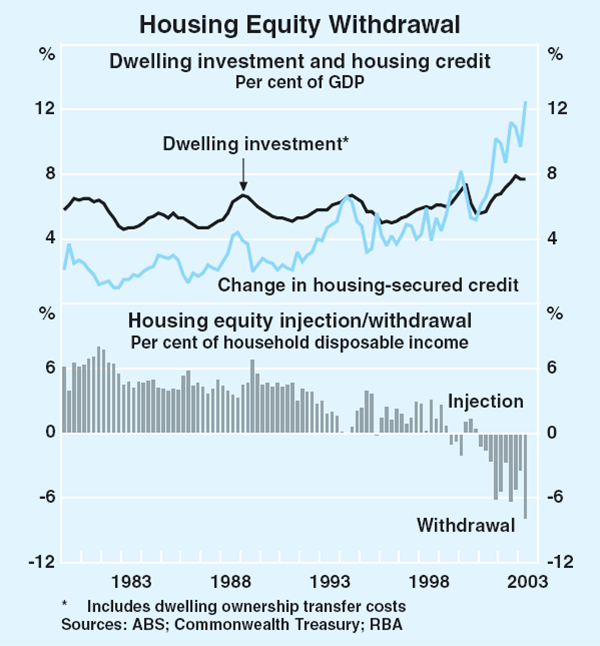
The expansion of household debt has meant that the debt-servicing ratio – the ratio of interest payments to disposable income – has increased further over the past year (Graph 29). Mortgage interest costs now represent 6½ per cent of aggregate household disposable income, a level that exceeds its previous peaks. Including interest on other forms of household borrowing, total interest costs now stand close to 8 per cent of household income. Although this ratio remains below the peak reached at the end of the 1980s boom, a continuation of current rates of credit growth would see the late-1980s peak exceeded sometime in 2004. This is notwithstanding the fact that in the late 1980s interest rates were at much higher levels than they are at present, and a greater proportion of household debt was in the form of more costly personal loans rather than mortgages.
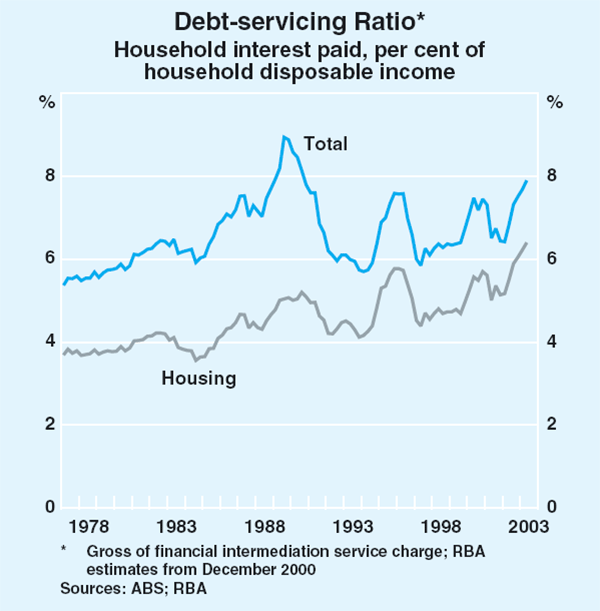
Housing
Activity
After peaking at around historically high levels in late 2002, housing construction activity declined slightly in the first half of 2003. Recent strength in leading indicators, however, suggests that contrary to earlier expectations, the level of activity is likely to recover in coming quarters. The cyclical downturn anticipated at the beginning of the year appears to have been remarkably modest in comparison with previous housing cycles.
Dwelling investment declined by 4½ per cent over the first half of 2003, with most of this decline occurring in the June quarter. This follows a period of very strong increases, which saw dwelling investment contribute over a percentage point to annual growth in GDP in 2002.
The recent fall in new dwelling construction reflects a decline in the construction of new houses, while activity in the medium-density sector increased strongly over the first half of the year. This pattern is expected to be reversed somewhat over the second half of the year, as activity in the house-building sector begins to pick up and growth moderates in the medium-density sector. Overall, new residential construction is likely to recover from the recent falls before stabilising in 2004.
This assessment is supported by leading indicators of housing demand. The number of building approvals for detached houses has remained at a high level in recent months, following the sharp rise recorded around the middle of the year (Graph 30). Display-home traffic and land sale enquiries are also showing signs of renewed strength. In addition, renovation activity has been stronger recently, with building approvals for alterations and additions having risen by around 13 per cent in the September quarter and lending for this purpose also growing rapidly in recent months.
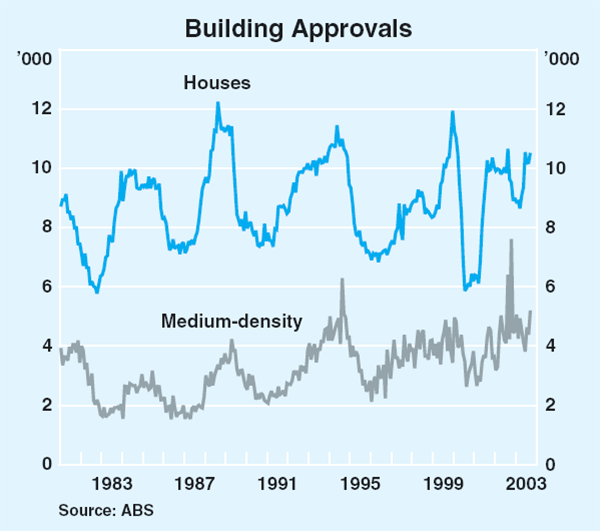
Building approvals in the volatile medium-density sector fell by around 25 per cent in the first half of the year, but showed renewed strength in the September quarter. Despite the pronounced fall in approvals in the first half of the year, the level of activity is not expected to decline in the second half of 2003 given the large amount of work still in the construction pipeline. Beyond this, declines in medium-density approvals may be in prospect, with housing bodies reporting that sales of new apartments have fallen to around half their peak in late 2001. Another factor likely to constrain new development is that the supply of apartments coming onto the market is expected to increase significantly over the next few quarters, given that commencements have been running well ahead of completions since early 2002. This is likely to add to the oversupply in some inner-city markets.
Overall, the current level of building approvals is broadly in line with most analysts' estimates of underlying requirements for new housing. Stronger population growth, faster household-formation rates and an apparent increase in the rate of demolitions have all contributed to a somewhat higher estimated level of underlying demand for new housing over the past five years. This strength is a key factor underpinning the medium-term outlook for residential construction.
Financing and prices
Housing credit continues to grow at a rapid rate. Over the three months to September it increased at an annualised rate of 25 per cent, compared with growth of around 21 per cent over the previous three-month period. Furthermore, new loan approvals continue to increase strongly and are at a very high level (Graph 31). Over the past three months, the value of total loan approvals has risen by 12 per cent to be 31 per cent higher than a year earlier. Approvals for loans to investors have been particularly strong, rising by almost 40 per cent over the past year; these now account for a record high 43 per cent of total approvals. Given the strong growth in approvals, there is little prospect that the rate of housing credit growth will slow in the short term.
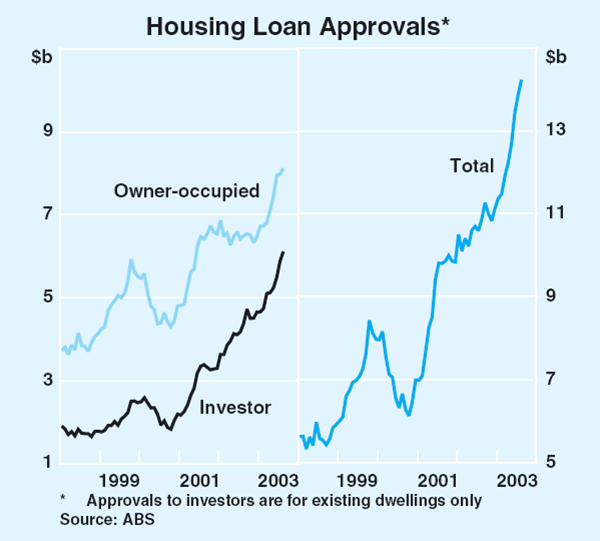
The rapid credit growth for housing has been associated with strong gains in housing prices. According to the ABS measure, prices rose, on average, by 5 per cent in the June quarter to be 18 per cent higher over the year, with strong gains being recorded in all major capital cities (Graph 32). The limited data available for the September quarter suggest that strong price rises have persisted into the second half of 2003. According to data from the Commonwealth Bank of Australia, established house prices grew by 9.1 per cent in the September quarter, to be almost 29 per cent higher over the year.
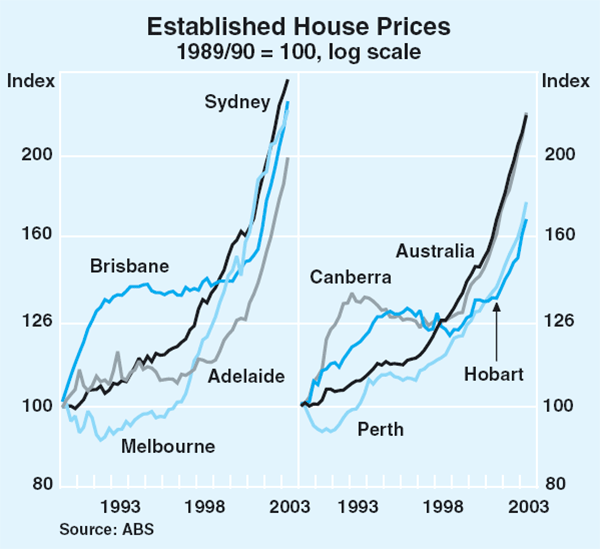
Apartment prices, on average, also continue to rise rapidly, though at a slower pace than house prices. There is, however, evidence of weakness in apartment prices in the inner-city areas of Sydney and Melbourne where strong investor demand over recent years has contributed to a large increase in supply. Data from Australian Property Monitors show that inner-city apartment prices in Melbourne have fallen by around 4 per cent from their peak, while prices in Sydney have fallen by about the same amount over the two quarters to June, though they remain 8 per cent higher over the year. There is no evidence at this stage that this weakness is spreading to apartment prices more broadly.
In contrast to prices, apartment rents have shown little or no growth over recent years. Rents in inner Melbourne, where concerns about oversupply have been most pronounced, have declined considerably over the past year, while rents in inner Sydney have been broadly flat for some time (Graph 33). In those markets where rents have been rising, the increases have fallen well short of the increases in prices, leading to a further decline in rental yields. These yields are now very low by historical standards and in comparison with yields in other countries.
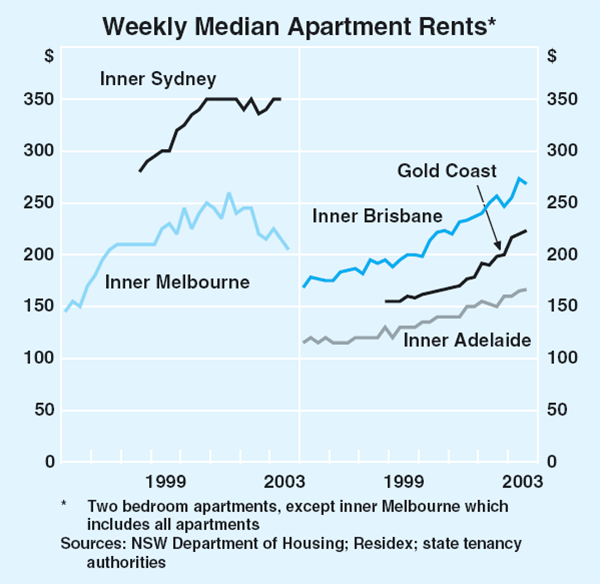
Business sector
Conditions for many businesses have picked up over recent months, with measures of confidence improving in line with signs of renewed strength in the domestic and world economies. The general improvement comes after a year in which there were marked divergences in the performance of different sectors of the economy. For the year to June, output growth was strongest in those areas with greater exposure to the domestic economy, most notably in the construction and finance sectors (Graph 34). In contrast, a large contraction was experienced by the farm sector. Conditions were also weak in the mining sector and those parts of manufacturing oriented to export markets.
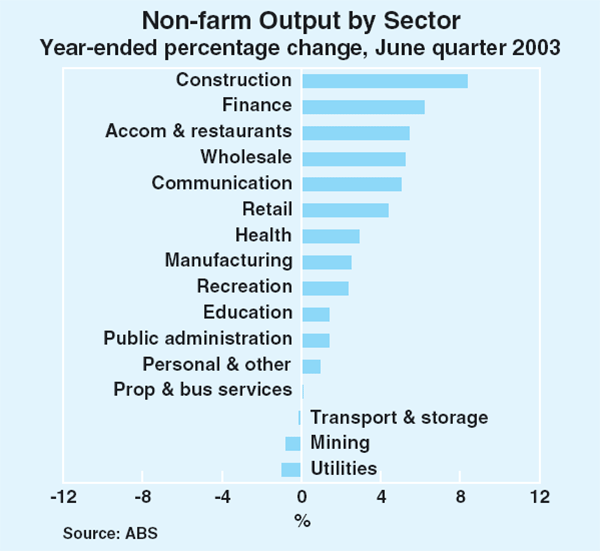
Looking forward, a more balanced growth profile is expected. As drought conditions have eased in most parts of the country, strong growth in farm production is likely to be recorded in the September quarter. The ABS is currently projecting an increase in production of nearly 40 per cent over the year to June 2004 (and a 28 per cent rise in 2003/04 as a whole), due almost entirely to a rebound in winter crop production (Graph 35). Prospects for irrigated crops and most livestock-related production, however, remain subdued (see ‘Box A: The Recovery from the Drought’ for further details). The brighter outlook for the global economy should help the mining sector, as well as tourism-related services (where recovery from SARS is already evident).
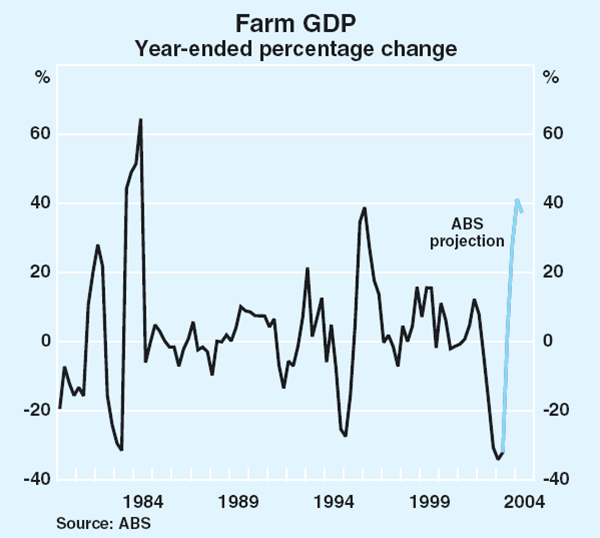
Business surveys confirm a significant improvement in business conditions over recent months. Most measures of confidence are now well above their long-run average levels and consistent with strong growth in domestic demand (Graph 36). The NAB survey of the non-farm sector, for example, reported that business conditions and confidence in the September quarter were at their highest levels since 1994. The recent improvement has been broadly based, with firms in all states and across most industries reporting better conditions than in the first half of the year; conditions are especially favourable in sectors with significant exposure to the domestic economy. Similarly, the ACCI-Westpac composite index of expectations for activity, comprising survey measures of employment, new orders, output and overtime, has recently risen to the highest level in the 35-year history of the series (Graph 37). The Australian Industry Group (AIG) survey of manufacturing also reported improved conditions, particularly for firms exposed to the housing sector, while in contrast, export-oriented manufacturing firms reported relatively weak conditions.
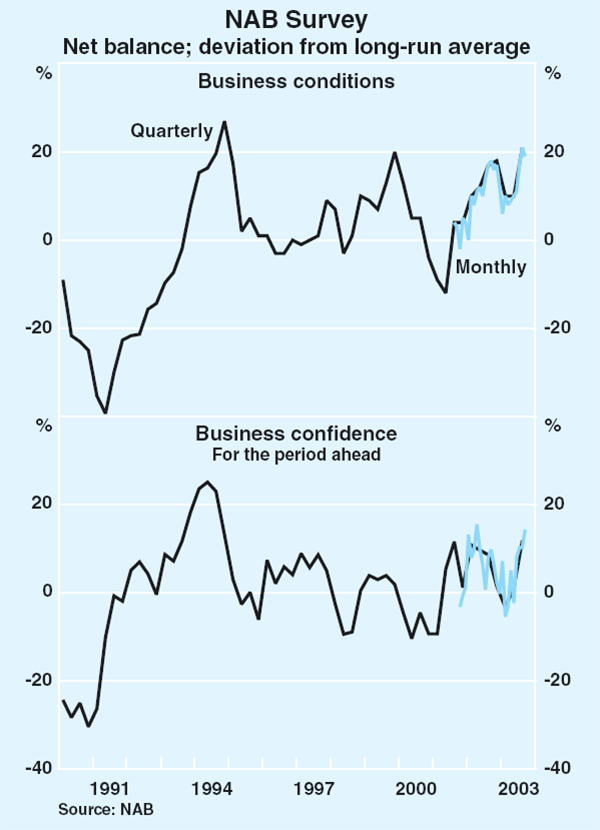
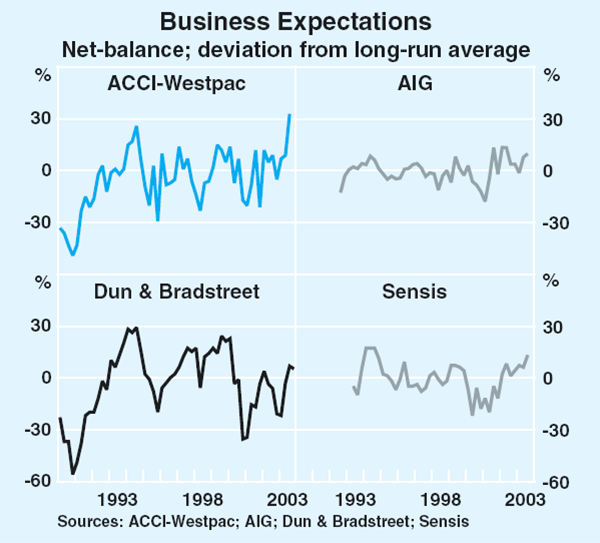
The level of profits relative to GDP remains high, although the slowdown in economic growth in the first half of 2003 has been associated with a slowdown in the rate of profit growth (Graph 38). In recent quarters, weakness in external demand and the adverse effects of the exchange rate appreciation on foreign-currency income have led to an overall decline in profits in the manufacturing and mining sectors, while farm-sector profits have also fallen owing to the continuing effects of the drought. In contrast, profitability has remained relatively strong in the construction, retail and wholesale trade sectors. Looking ahead to the second half of 2003, farm profitability is expected to recover in line with improved conditions in this sector. More broadly, the NAB business survey suggests that non-farm profitability has picked up considerably in the second half of 2003.
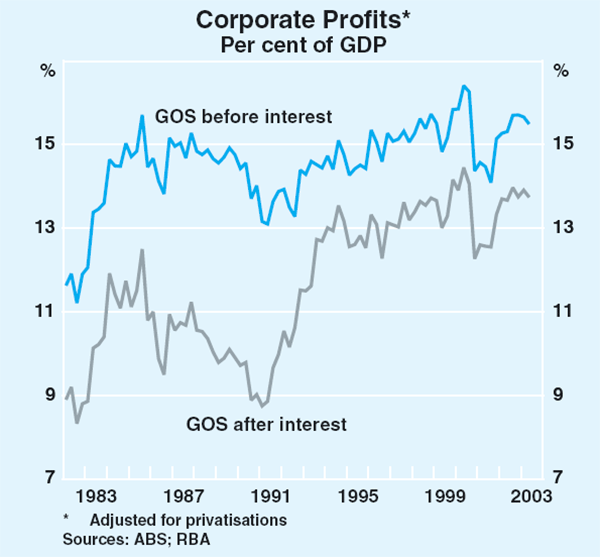
Generally healthy profits have meant that many firms have been able to continue to rely on internal funding to finance investment. Nevertheless, borrowing from financial intermediaries has picked up recently, rising by 7 per cent in annualised terms over the six months to September. In contrast, equity raisings by non-financial companies have recently been below the average level of the past few years, although a number of companies are expected to float in coming months. Overall, businesses do not appear to be constrained in obtaining finance. Corporate gearing ratios remain conservative, which together with low interest rates, has meant that interest payments by firms have remained at relatively low levels.
The outlook for business investment is positive, given the ready access to internal and external funding, the high levels of capacity utilisation and the high level of business confidence. This positive outlook comes after business investment rose by 13 per cent over the year to the June quarter, although by only 1 per cent in the June quarter itself (Graph 39). Machinery and equipment investment underpinned the positive quarterly outcome, increasing by 2 per cent. In contrast, buildings and structures investment was flat, following six consecutive quarters of remarkably strong growth, while spending on computer software fell for a second consecutive quarter.
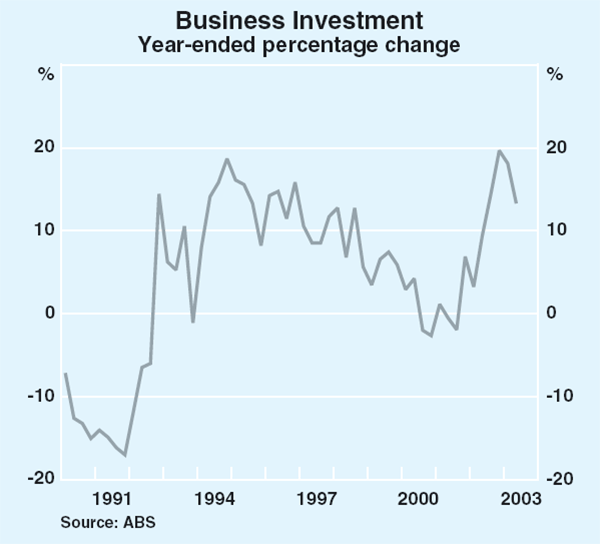
Indicators of investment intentions point to continued healthy growth in business investment, but at a more moderate pace than the rapid rate of the past year. The June quarter ABS capital expenditure (Capex) survey points to solid growth of machinery and equipment investment in real terms in 2003/04, although in nominal terms, investment is expected to fall by 3 per cent (assuming a five-year average realisation ratio), reflecting lower prices for investment goods. The mining sector is expected to make a sizeable contribution to equipment investment – nominal spending here is projected to rise by 7 per cent. Nominal equipment investment is also expected to increase substantially in the finance and insurance, property and business services, and utilities industries, but fall in most other industries, most notably in the communications sector.
Forward-looking indicators of buildings and structures investment point to strong growth in coming quarters (Graph 40). Engineering construction has risen by 36 per cent over the past year and the unprecedented amount of work yet to be done suggests further expansion in the next few quarters. Non-residential building activity is expected to remain strong; work yet to be done has risen by 32 per cent over the past year and approvals continue to hold at very high levels, exceeding work done in recent quarters. The outlook, however, varies significantly across sectors. Conditions in the office market continued to be soft over the first half of the year, with the national vacancy rate rising and effective office rents declining. In contrast, demand for retail and industrial property has been strong, with further gains in rents and industrial property capital values.

Labour market
The level of recorded employment has increased strongly over recent months, after declining earlier in the year. In the three months to October, the average level of employment was 2.2 per cent higher than a year earlier. Looking through the monthly volatility, employment appears to have grown at slightly above its trend rate over the past year (Graph 41).
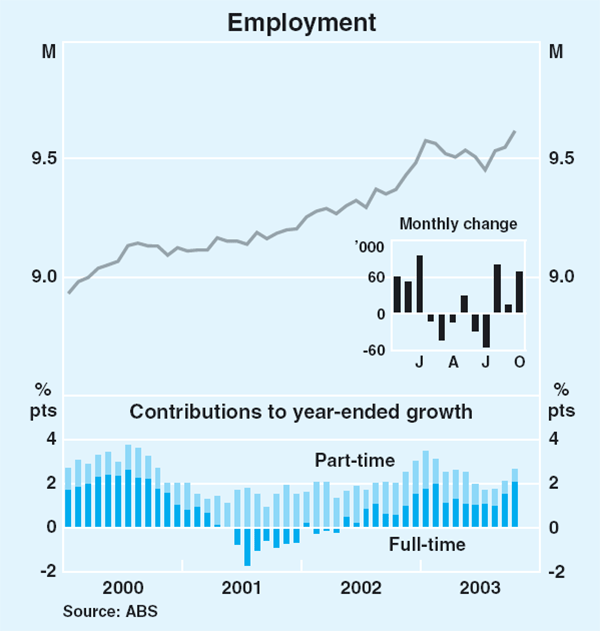
Over recent months the unemployment rate has fallen to 5.6 per cent, after it had moved in a narrow band of between 6 and 6¼ per cent for most of the past year. This suggests that the labour market is relatively tight. At its current level, the unemployment rate is equal to the low point of the late 1980s, and within ¼ percentage point of the lowest level of the past 25 years (Graph 42).
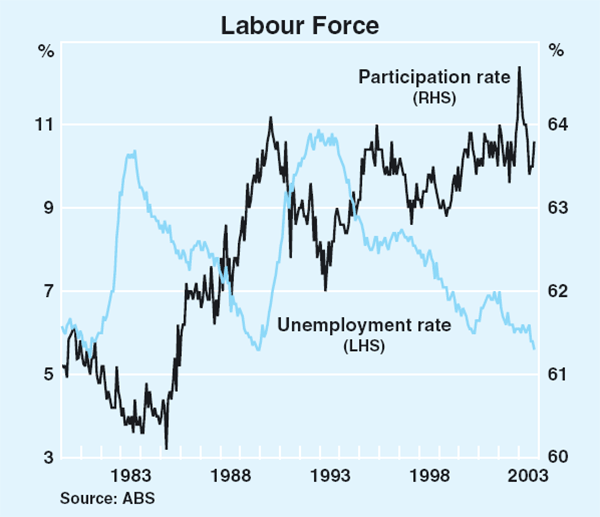
The gains in employment over the past year have occurred in all states, and those states with the highest unemployment rates in the three months to October 2002 have experienced the strongest growth and the largest declines in the unemployment rate (Table 11). As a result of this convergence, the unemployment rate is now below 7 per cent in all states for the first time since the 1970s.
| Employment growth | Unemployment rate | |||||
|---|---|---|---|---|---|---|
| Three months to October | Year to three months to October | Three months to October 2002 | Three months to October 2003 | Difference in percentage points | ||
| NSW | 0.8 | 2.0 | 5.7 | 5.5 | −0.2 | |
| Victoria | 0.6 | 1.7 | 5.9 | 5.4 | −0.5 | |
| Queensland | 1.5 | 3.7 | 7.1 | 6.4 | −0.8 | |
| Western Australia | −0.7 | 1.0 | 6.2 | 6.1 | −0.1 | |
| South Australia | −0.8 | 2.7 | 6.4 | 6.0 | −0.4 | |
| Tasmania | 2.3 | 5.1 | 8.4 | 6.8 | −1.6 | |
| Australia | 0.7 | 2.2 | 6.1 | 5.7 | −0.4 | |
|
Source: ABS |
||||||
Reflecting the pattern of output growth, employment growth has been strongest in the construction sector, where employment in the September quarter was 11.5 per cent higher than its level a year ago. In contrast, agricultural employment has fallen by 4.9 per cent over the past year (Table 12).
| Industries | Share of total 2002 Per cent | Year to September quarter 2003 Percentage change |
|---|---|---|
| Agriculture | 4.3 | −4.9 |
| Construction | 7.6 | 11.5 |
| Manufacturing | 12.0 | −3.1 |
| Wholesale and retail trade | 19.9 | 1.3 |
| Services | 45.7 | 1.1 |
| Other(a) | 10.4 | 6.7 |
| Total | 100.0 | 1.8 |
|
(a) Utilities, mining, transport and storage, and public administration and defence Source: ABS |
||
Looking forward, recent job vacancy and hiring intentions data point to continued solid employment growth over the remainder of the year and into 2004, with print- and internet-based indicators of labour demand improving over recent months, following weakness over the first half of the year (Graph 43). Business surveys are also pointing to strong employment growth. The NAB survey of employment intentions for the quarter ahead is at its highest level in almost a decade, while the ACCI-Westpac survey is also near a decade high. In contrast, the ABS job vacancies measure has fallen in each of the past two quarters, although it remains above the average seen since 1990.
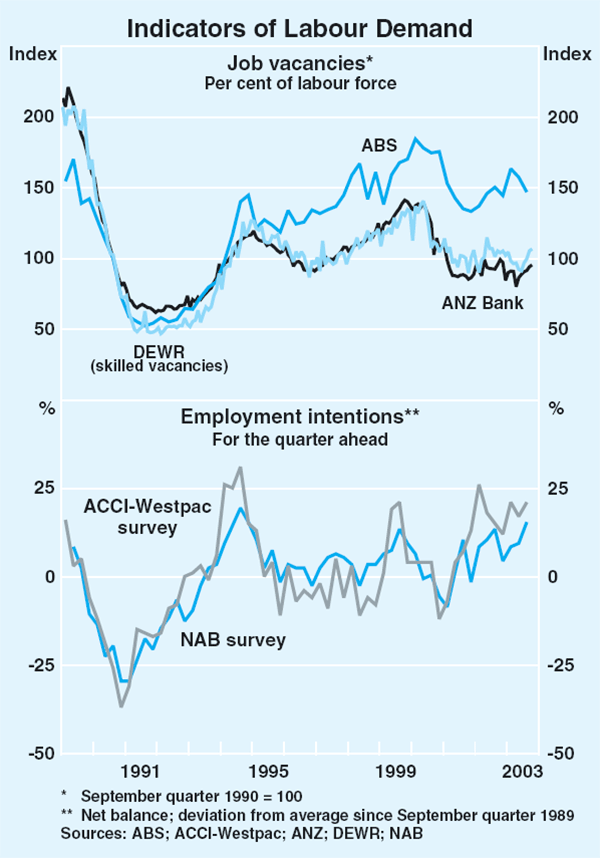
Balance of Payments
Weak growth in the world economy and the drought in Australia have seen export earnings decline over the past couple of years (Graph 44). At the same time, robust growth in domestic demand has underpinned strong growth in the volume of imports. The result has been a substantial widening of the deficit on trade in goods and services. In the September quarter, this deficit stood at around 3 per cent of GDP, somewhat smaller than in the previous quarter, but still around 2 percentage points larger than the average over the past decade. Correspondingly, the current account deficit has also widened over the past couple of years, although the deficit for the September quarter, at around 6 per cent of GDP (assuming that the net income deficit remains constant as a share of GDP), is likely to have been smaller than in the previous quarter.
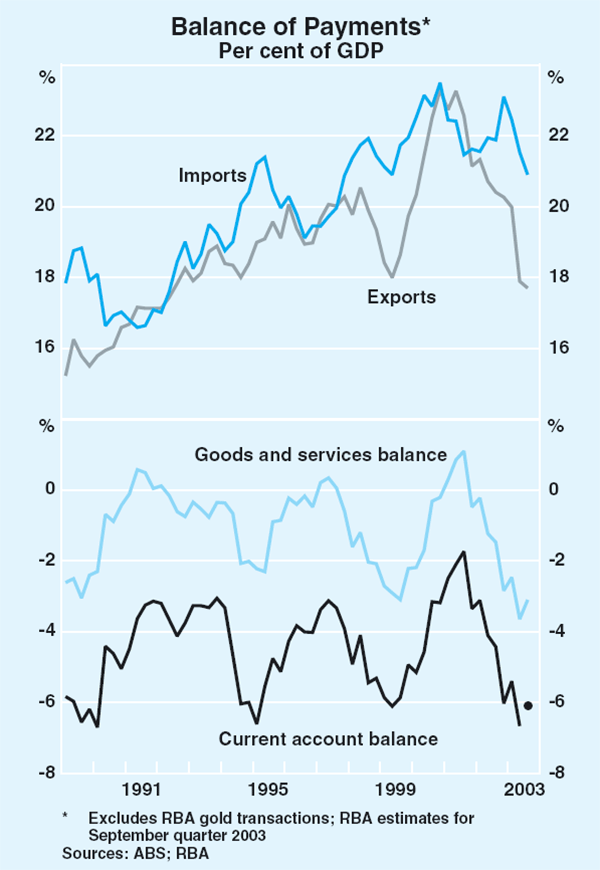
While exports have been weak for some time, there have been tentative signs of a recovery over recent months. This recovery is most evident in earnings from service exports, which rebounded strongly in the September quarter, to be about 3½ per cent higher than the average level since the 2000 Sydney Olympics (Graph 45). This rebound reflects a general recovery in international travel following the containment of SARS, with the number of short-term visitor arrivals in September the highest in over two years and well above the level recorded prior to the war in Iraq and the SARS outbreak (Graph 46). Arrivals are currently being boosted by the Rugby World Cup, which should see a further pick-up in service exports in the December quarter.
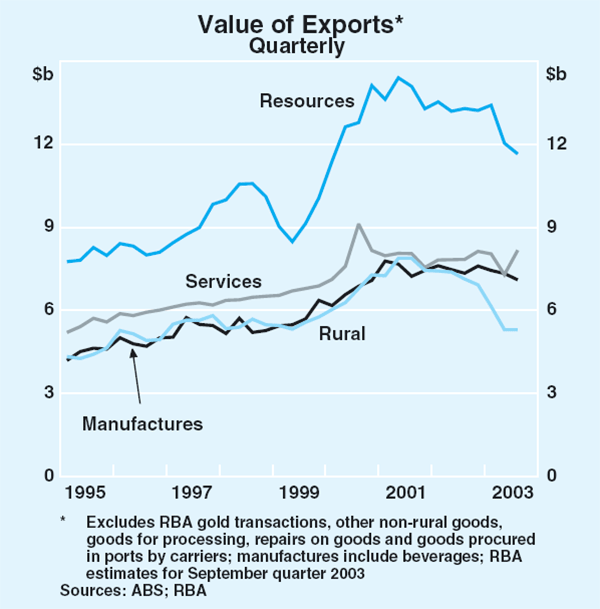
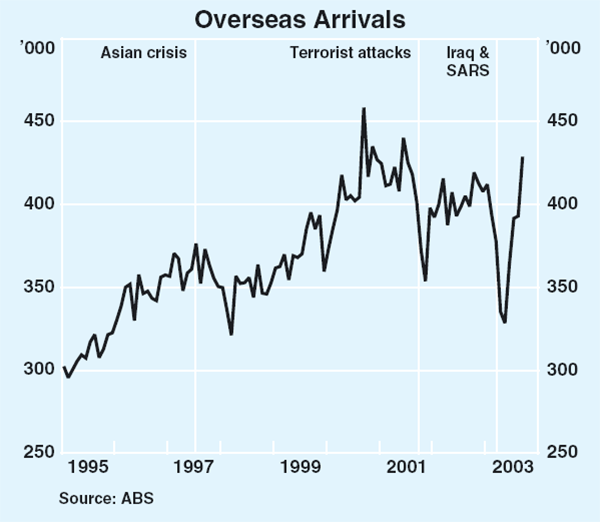
The outlook for the rural sector has also improved over recent months. This follows a period in which rural export earnings were adversely affected by drought, falling by almost 30 per cent since mid 2002. Crop production, particularly wheat, is expected to drive the recovery in exports in 2003/04, although a substantial pick-up will not be evident until the December quarter, when the bulk of the winter crop harvest occurs. In contrast, meat and live animal exports are expected to fall in the near term, as farmers have begun to re-stock herds and flocks now that pasture conditions have improved (see ‘Box A: The Recovery from the Drought’ for further details).
As with rural exports, proceeds from resource exports have been weak over recent quarters, with export earnings falling by around 3 per cent in the September quarter and by around 12½ per cent over the past year. This decline reflects both the general weakness in the world economy and the appreciation of the Australian dollar over the period. The run of recent monthly data, however, suggests that earnings from resource exports have passed their trough. Global demand for resources is improving, with industrial production growing strongly in China and economic growth picking up in other regions, particularly the US and Japan. Although capacity constraints are an issue in some parts of the resources sector, they are expected to ease in time, given the high level of investment intentions in the mining sector (see the chapter on ‘Domestic Economic Conditions’).
Manufactured export values have been broadly flat over the past two years, in contrast to average annual growth of over 10 per cent in the 1990s. As with resource exports, weak world demand and lower Australian dollar prices have both played a role. However, volumes are estimated to be moderately higher in the September quarter than a year earlier and the pick-up in world growth should see a recovery in manufactured exports.
Overall, export earnings rose by around 1½ per cent in the September quarter, driven by the services component, but were still about 8½ per cent lower than a year ago. The recent downward trend in export volumes has been much less pronounced than that in export values. The latest monthly data suggest that export volumes are picking up; over the past two months the value of exports has increased by 5½ per cent, despite lower Australian dollar prices (Graph 47). Moreover, exporters report generally positive expectations about growth in overseas demand in the period ahead.
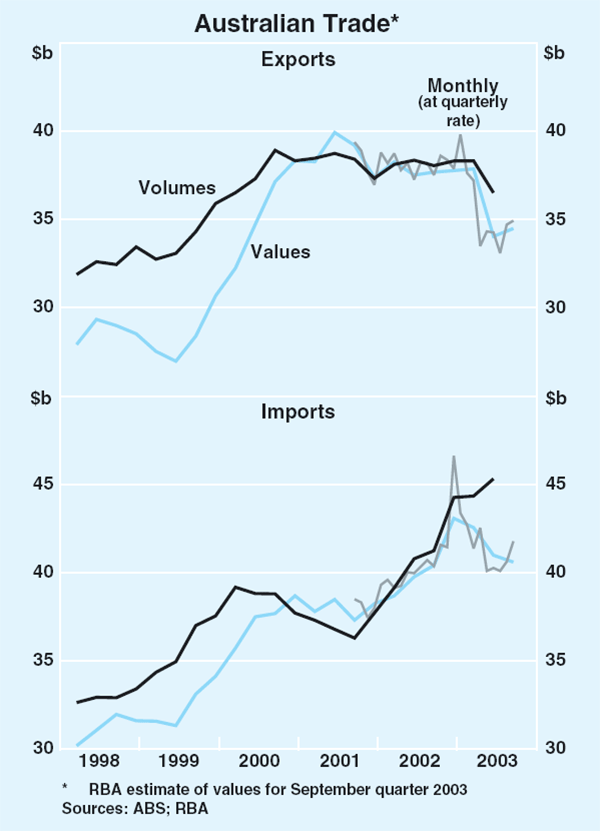
In contrast to exports, import volumes have grown solidly over the past two years, due to robust growth in domestic demand. The pace of growth moderated in early 2003, however, in line with the easing in the rate of growth of domestic spending and the dropping-out of one-off factors such as large purchases of civil aircraft. The volume of imports rose by 2¼ per cent in the June quarter, which is a little above trend rates, and is likely to record a similar increase in the September quarter. In value terms, though, imports have fallen by around 5¾ per cent since the end of 2002, reflecting a substantial fall in import prices due to the Australian dollar's appreciation.
The net income deficit has remained around 3 per cent of GDP over the past four years, which is lower than the average for the 1990s. While falling world interest rates have reduced the servicing cost of foreign debt over the past two years, this has been offset by rising dividend payments on foreign holdings of Australian equity, reflecting the strong profit growth of Australian companies throughout this period.
Commodity prices and the terms of trade
The RBA Commodity Price Index rose by 4.3 per cent in SDR terms in the three months to October, driven by rises in the prices of rural goods and base metals, to be 1.7 per cent higher than a year ago (Graph 48). Even though the Australian dollar has appreciated, the RBA Commodity Price Index in A$ terms remains slightly above its average over the past 10 years.
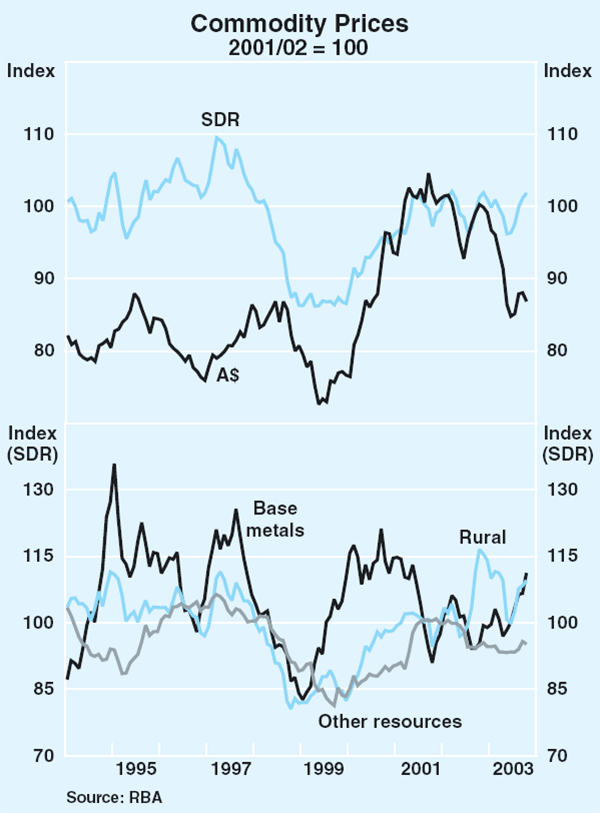
Beef prices increased by 12 per cent in SDR terms in the three months to October, as demand in the US recovered from earlier weakness. Supply has also been constrained by herd rebuilding in Australia and the US, following the easing in drought conditions in both countries. The price of wheat has risen by 8½ per cent in the past three months, as adverse weather conditions in Europe have reduced the expected size of the world wheat crop for 2003/04. Despite the rise, the price of wheat is still well below the level of a year ago, when drought conditions were adversely affecting production in Australia, the US and Canada.
Base metals prices have increased steadily over the second half of 2003, in line with the brightening outlook for world industrial production and robust demand from China, in particular. Nickel prices rose sharply in the past three months; low stocks and a 13-week strike at a Canadian nickel producer provided additional support to prices. The prices of other resource commodities also rose moderately in the three months to October. The increase in the price of gold was particularly marked, at 5 per cent in the three-month period and 11 per cent over the year.
In the three months to October, the West Texas Intermediate crude oil price averaged US$30 per barrel, largely unchanged from the previous three months (Graph 49). The OPEC basket of oil prices has now averaged above the US$25 midpoint of OPEC's target range for almost a year. After declining over the first half of September as US inventories increased and US demand eased, prices rose following OPEC's unexpected decision to reduce oil production quotas by around 3½ per cent, effective from November. The new production target is the same as that prevailing prior to the outbreak of hostilities in Iraq. This follows increased production by non-OPEC members and a build-up of inventories, as well as some recovery in Iraq's oil production.
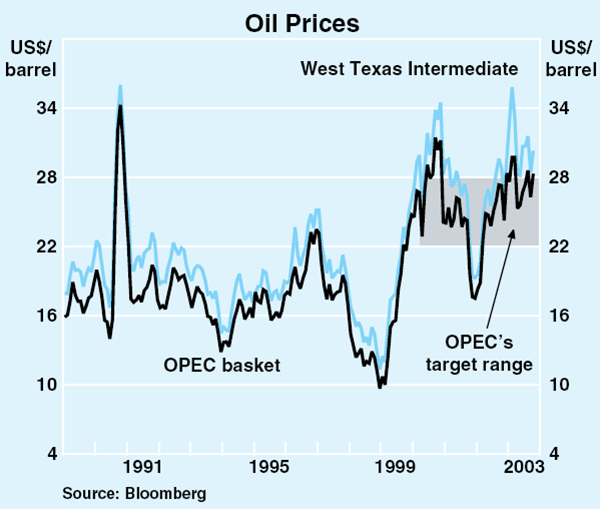
Overall, world prices for many of the commodities that Australia exports have held fairly steady over the past few years, despite the weakness in the world economy. In contrast, world prices of manufactured goods, which Australia predominantly imports, have generally been under downward pressure, reflecting the ongoing declines in the prices of information-technology products and the rapid expansion of productive capacity in Asia, especially China. The result has been an increase in Australia's terms of trade, including a 2 per cent rise over the first half of 2003, to its highest level since the late 1980s (Graph 50). A further increase is likely in the September quarter.

Box A: The Recovery from the Drought
Drought conditions have eased across most agricultural regions over recent months. Winter rainfall was generally above average, and although September was unseasonably warm and dry in New South Wales and Queensland, good rainfall occurred in October. The Bureau of Meteorology's latest rainfall outlook suggests average rainfall over the remainder of the winter cropping season.
Farm production is therefore expected to recover strongly in 2003/04. ABS projections, based on forecasts by the Australian Bureau of Agricultural and Resource Economics (ABARE), are for a 28 per cent rise in farm GDP in 2003/04. The expected recovery would contribute to aggregate growth in 2003/04 by about ¾ of a percentage point (Graph A1). This follows a 27.5 per cent fall in farm GDP in 2002/03, which subtracted 1 percentage point from aggregate growth. The expected recovery in farm incomes over 2004 is also likely to have positive flow-on effects to industries that supply and service agricultural activities.
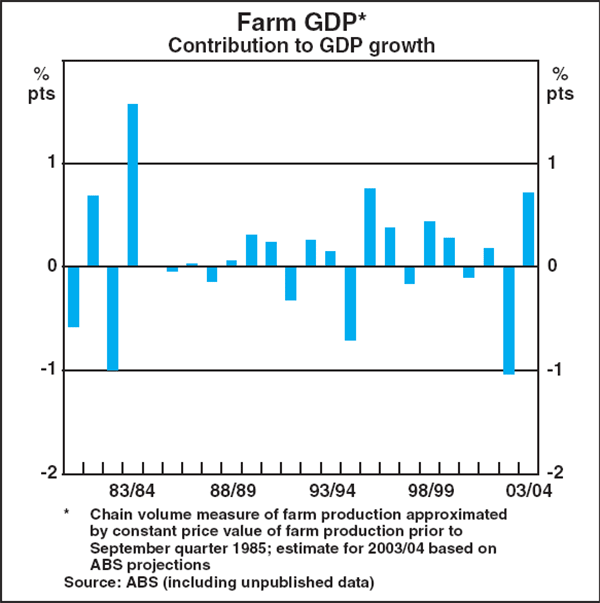
The rebound in farm GDP will be concentrated in winter crop production, with other areas of agricultural production continuing to be subdued. While the first large increase in output will be recorded in the September quarter, the recovery in exports will begin in the December quarter, once the crop has been harvested and shipment occurs.
Largely because rainfall throughout 2003 has been quite patchy, the recovery is expected to be somewhat more subdued than has previously been seen following major droughts. Farm GDP in 2003/04 is likely to be around 7 per cent below the pre-drought level recorded in 2001/02, with winter crop production likely to be 5½ per cent lower than the pre-drought level. While conditions in Western Australia have been excellent, patchy rainfall across the eastern grain belt led to some late plantings and thus lower expected yields. Furthermore, the recovery in summer crop production in 2003/04 is expected to be more muted than is typical, since the continuing shortage of stored water will constrain production of irrigated crops such as rice and cotton, particularly in New South Wales.
While livestock-related production normally comprises around half of farm production, it is not expected to contribute to the recovery in farm output in 2003/04. In drought years, farmers generally increase slaughter rates rather than incur the high costs of retaining stock. The subsequent rebuilding of livestock numbers takes time, so recoveries of livestock-related production from drought are generally more protracted than those for crop production. This is particularly the case on this occasion, given the severity of the recent drought.
The re-stocking process will mean that meat production and live animal exports will fall significantly in 2003/04. Lower sheep numbers will also result in a fall in wool production, but dairy production is expected to rise slightly.
Domestic Financial Markets
Interest rates and equity prices
Money and bond yields
The target cash rate was raised from 4.75 per cent to 5 per cent following the November meeting of the Board. This was the first adjustment to the target since June of last year. While the tightening occurred slightly sooner than expected by many commentators and market participants, expectations of a tightening had been building since the last Statement in response to the continued strong performance of the local economy and a more optimistic tone in overseas markets. This was reflected in increases in short-term market yields over the period. Yields on 90-day bank bills had risen by around 25 basis points ahead of the change in the target and rose further after, indicating expectations of some further tightening of policy in the months ahead (Graph 51).

Long-term government bond yields have also risen since the release of the last Statement (Graph 52). Yields on 10-year bonds are currently around 5.90 per cent, which is back around the levels of a year ago after the sharp dip in the first half of 2003.
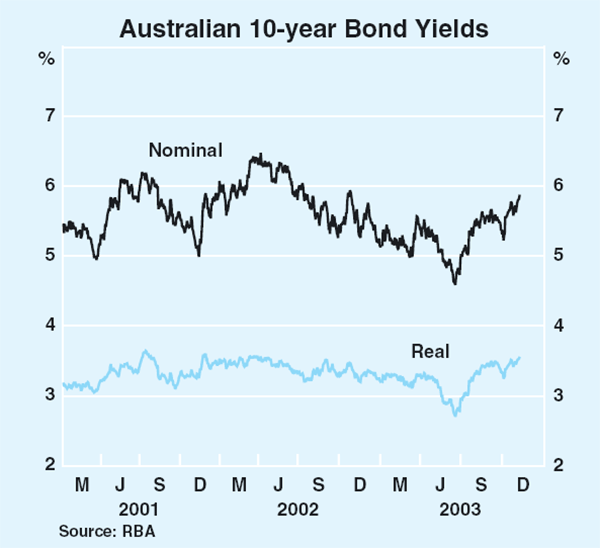
Like nominal yields, indexed bond yields have recorded a net increase over recent months. Ten-year real yields now stand at 3.6 per cent, around 25 basis points above their level in early August.
The yield curve has changed markedly in shape over the past few months (Graph 53). At the height of the pessimism about the world economy in June, 2-year yields were 70 basis points below the cash rate, and even 10-year yields were about 15 points below the cash rate, indicating the market expected that domestic interest rates might need to be cut in response to the external weakness. A lot of this pessimism had already been reversed by the time of the previous Statement in August, but since then yields have risen by a further 45–85 basis points across the yield curve, as market confidence has improved.
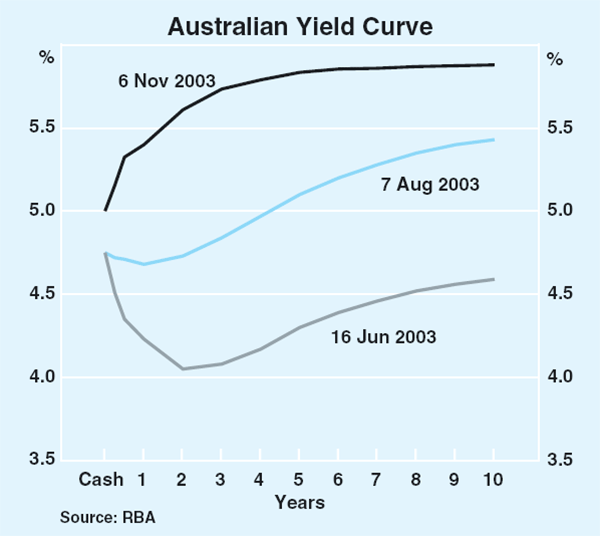
Spreads between yields on highly-rated corporate bonds and government bonds rose slightly over the past three months (Graph 54). In contrast, there has been a narrowing in spreads on lower-rated bonds. Spreads on bonds rated BBB are now about 40 basis points below their peak seen a year ago, suggesting investors have become more confident about corporate credit worthiness.
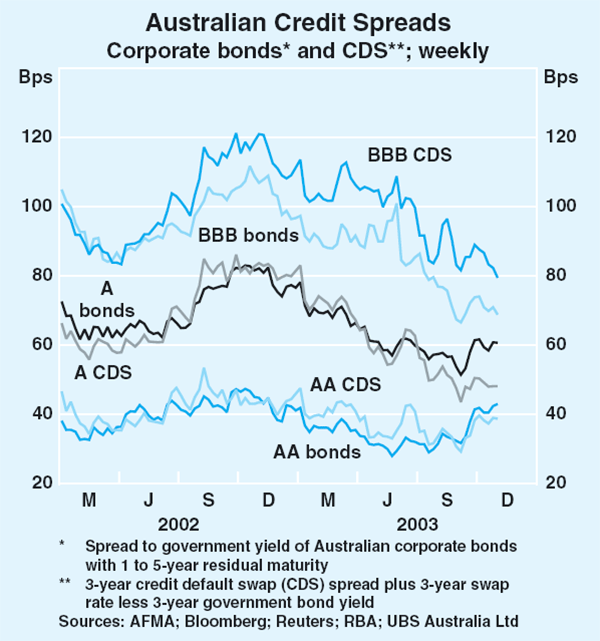
Intermediaries' interest rates
Indicator rates on variable-rate housing and business loans were unchanged between mid 2002 and early November. While some mortgage managers and small lenders have raised rates, at the time of writing most financial institutions had not yet responded to the November policy tightening. For most of the period between the mid 2002 and November 2003 tightenings, fixed rates steadily declined, reaching a trough in June 2003. At that point they were well below rates on variable-rate loans. Recently, however, fixed rates offered by intermediaries have been rising again due to rises in banks' funding costs in capital markets. Since the last Statement, 3-year fixed rates on business loans have risen by 70 basis points while those on housing loans have risen by around 60 basis points. Three-year fixed rates on housing loans are currently around the same as those on variable-rate housing loans (Graph 55).
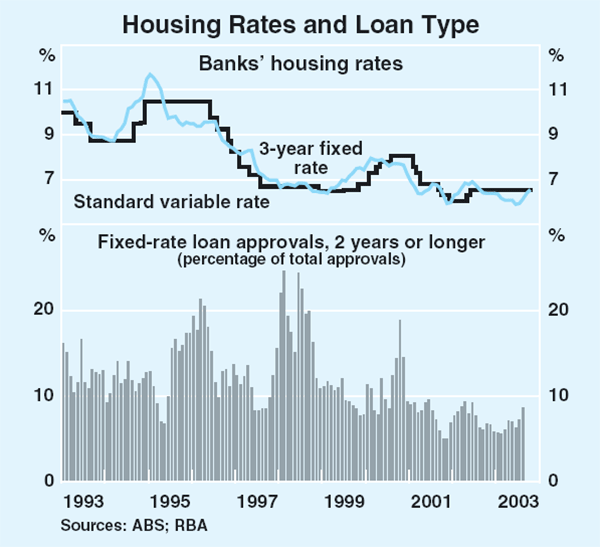
Despite the increase in fixed housing rates, the share of new loans taken out at fixed rates has risen, suggesting that borrowers had factored in some likelihood of an increase in variable interest rates. The share of fixed-rate loans, nonetheless, remains low relative to that seen for most of the 1990s.
Equity prices
The Australian share market has risen by 4 per cent since the last Statement to be 20 per cent above its mid-March low. In recent months, the Australian share market has performed broadly in line with the US share market (Graph 56). Further comparisons of Australian and US share returns are given in Box B.

The rise in Australian share prices over the past three months has been broadly based, with most sectors experiencing gains (Graph 57). Cyclical sectors – i.e. those most responsive to the economy – have performed particularly well. The materials sector has recorded very strong gains, reaching a new record high in mid October, buoyed by rising metals prices and increased optimism that demand for exports will increase as the global economy recovers. The consumer discretionary sector has also outperformed. The financials sector has fallen marginally, with a rise in insurers' share prices offset by falling equity prices for banks. The gains in the former reflect a 34 per cent jump in AMP's share price since the end of July.
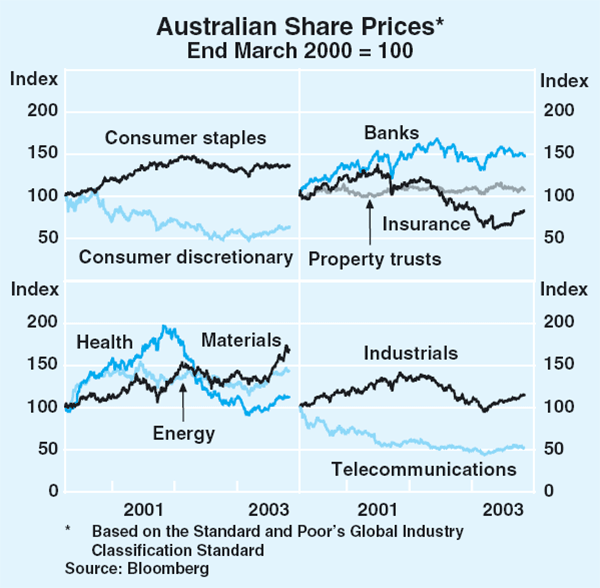
Most companies in the ASX 200 have reported either annual or interim profit results in recent months. Aggregate net profits for the first half of 2003 were 10 per cent higher than those reported in the same period last year, excluding News Corporation and AMP whose profits have been affected by special factors. (News Corporation reported an $11 billion loss in the six months to June 2002, reflecting write-offs, while AMP reported a record loss of more than $2 billion for the first half of this year.) The telecommunications sector recorded particularly strong growth in net profits, with Telstra reporting an increase of 44 per cent on the same period last year. Profit results were also strong in the financials (excluding AMP) and materials sectors.
Overall, the market viewed the reporting season as successful, with a majority of companies meeting or exceeding analysts' most recent forecasts. Despite the strong result in the latest half year, weakness in the previous half meant that net profits for the year to June 2003 were around 1½ per cent lower than in the year to June 2002. The stronger results for the latest half year have led analysts to revise upwards their forecasts for 2003/04 earnings per share.
The Australian price-earnings (P/E) ratio has remained around 20 in recent months, above its long-run average but still well below the US P/E ratio (Graph 58).
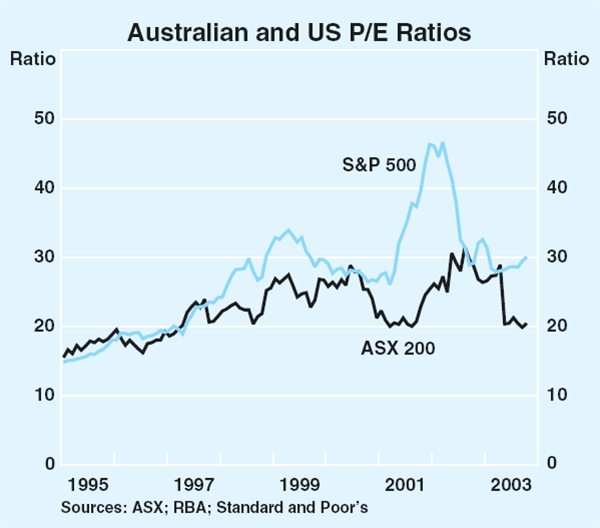
Financing activity
Debt markets
Australian non-government entities were again active in bond issuance in the September quarter, with record activity in the domestic market and continued strong issuance into offshore markets (Table 13).
| Sector | 2000 | 2001 | 2002 | 2003 | ||
|---|---|---|---|---|---|---|
| Year to June | September quarter | October | ||||
| Bond issues by Australian entities | ||||||
| Onshore | ||||||
| Financial institutions | 5.1 | 6.0 | 7.4 | 4.7 | 2.4 | 0.1 |
| Non-financial companies | 7.6 | 5.9 | 7.6 | 2.2 | 1.3 | 0.7 |
| Asset-backed | 11.3 | 15.0 | 19.3 | 6.4 | 9.1 | 2.6 |
| Total | 24.1 | 26.9 | 34.3 | 13.3 | 12.8 | 3.3 |
| Offshore | ||||||
| Financial institutions | 23.2 | 29.3 | 31.8 | 29.7 | 9.9 | 4.1 |
| Non-financial companies | 4.4 | 6.8 | 7.5 | 9.4 | 3.0 | 1.1 |
| Asset-backed | 8.9 | 14.3 | 16.5 | 11.5 | 7.8 | 2.8 |
| Total | 36.6 | 50.4 | 55.9 | 50.6 | 20.6 | 7.9 |
| Total | 60.7 | 77.3 | 90.2 | 63.9 | 33.5 | 11.2 |
| A$ bond issues by non-resident entities | ||||||
| Onshore | 3.5 | 7.8 | 3.1 | 0.9 | 3.4 | 0.5 |
| Offshore | 1.0 | 4.3 | 17.3 | 17.4 | 2.9 | 1.8 |
| Total | 4.5 | 12.1 | 20.4 | 18.3 | 6.3 | 2.3 |
|
Source: RBA |
||||||
Total bond issuance by Australian non-government entities amounted to $33 billion in the September quarter, in line with the June quarter and well ahead of the quarterly rate in 2002. Asset-backed vehicles issued $17 billion, double their issuance in the June quarter and split fairly evenly between the domestic and offshore markets. Most asset-backed issues were backed by residential mortgages, reflecting continued rapid growth in housing finance.
Issuance by financial institutions eased in the September quarter, reflecting larger-than-initially planned issuance during the first half of 2003 (because of oversubscriptions) and increased issuance of hybrid and asset-backed securities. Financial institutions' bond issuance returned to more normal levels in October, but most issuance was into offshore markets.
At around two-thirds, the share of Australian entities' issuance that went into offshore markets was noticeably lower than in the first half of 2003, when offshore issuance was particularly strong, but broadly consistent with its average of the previous two years.
Most offshore issuance by Australian borrowers in the September quarter was denominated in foreign currencies (with companies typically using swap markets to hedge the proceeds back to Australian dollars). At just over 50 per cent, the share of foreign currency issuance denominated in US dollars was below past norms; financial institutions issued substantial amounts in euros and pounds sterling.
Non-residents issued a total of $6.3 billion of Australian dollar denominated debt in the September quarter, with issuance fairly evenly divided between domestic and offshore markets. European and US financial institutions accounted for most of the strong domestic issuance, taking advantage of a narrowing in cross-currency interest rate swap spreads to diversify their funding sources at a globally competitive cost.
Even after record-level maturities in the September quarter, gross issuance of non-government debt into the domestic market was sufficient to see the stock of such debt outstanding rise to $134 billion by end September (Graphs 59 and 60). In contrast, Commonwealth Government bonds fell to $52 billion due to a large maturity while state government bonds outstanding declined slightly.
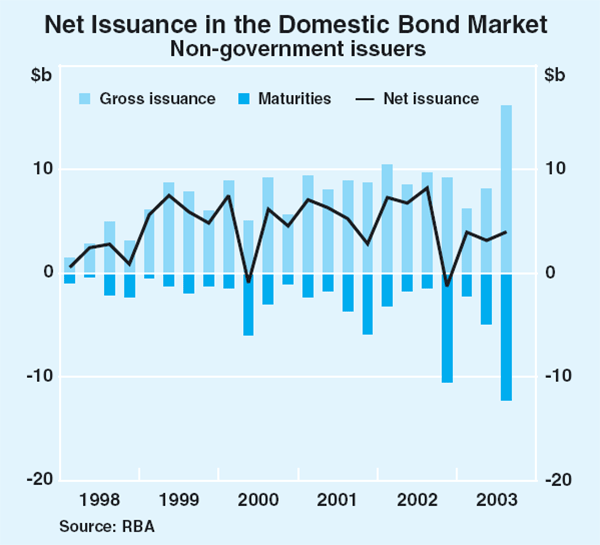
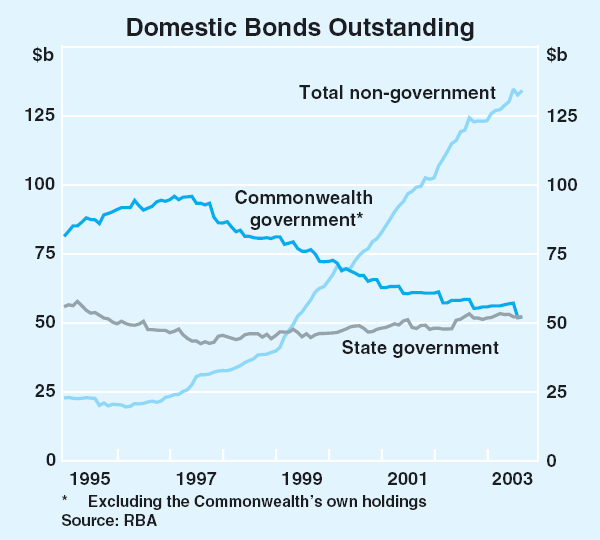
The ongoing process of product innovation in the domestic market was marked by two more developments last quarter. The first was the issue of an asset-backed bond backed entirely by low-documentation mortgages. These bonds were used to fund specialist ‘non-conforming’ lenders that have entered the Australian market in the past two years. The second was the introduction of several high-yielding portfolio credit-linked notes that were targeted at retail investors.[1] The marketing of these products to retail investors contrasts with practices seen in the US and European markets, where these securities are primarily sold to institutional investors.
Hybrid securities
Issuance of hybrid securities (securities which are a mixture of both debt and equity) reached a record $4.7 billion in the September quarter, mostly in offshore markets (Graph 61). The major banks dominated hybrid issuance, issuing securities in Australia, the United States, and for the first time, the United Kingdom.
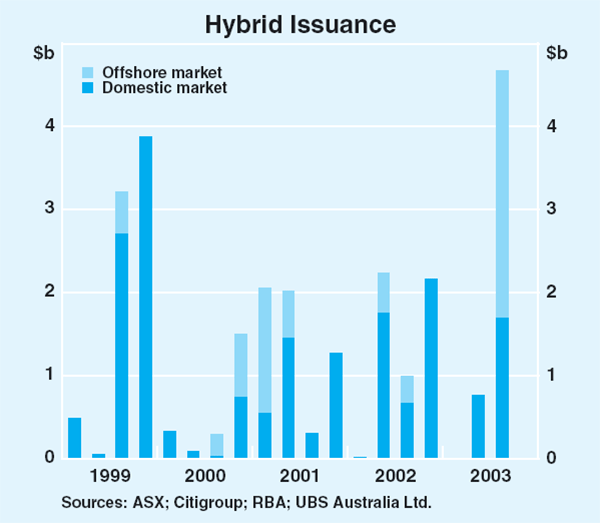
Intermediated borrowing
The growth rate of total credit has increased further in recent months – to an annualised rate of 15.2 per cent over the six months to September – with household credit growth picking up from already high levels and stronger growth in business credit (Graph 62).

Household credit growth continues to be driven by borrowing for housing, though personal credit has also grown strongly over recent months. Growth in housing credit rose slightly in the past few months and is now running at an annualised pace of around 23 per cent over the six months to September. Within this, borrowing by investors has been particularly strong, increasing by 33 per cent in annualised terms over the same period.
Business credit growth has also picked up since the middle of the year to an annualised rate of 6.8 per cent over the six months to September, more than double the rate over the six months to May. This was mainly attributable to commercial loans to private trading corporations and unincorporated businesses, while issuance of bank bills (also included in business credit) has been more modest in recent months.
On the liability side of intermediaries' balance sheets, growth in the broader monetary aggregates has been lower in recent months, with annualised growth in broad money of 10.5 per cent over the six months to September, compared with growth of 14.3 per cent over the six months to May (Graph 63). The divergence between growth of credit and broad money over the year reflects financial institutions accessing funding sources, such as offshore borrowing, which are not included in broad money.
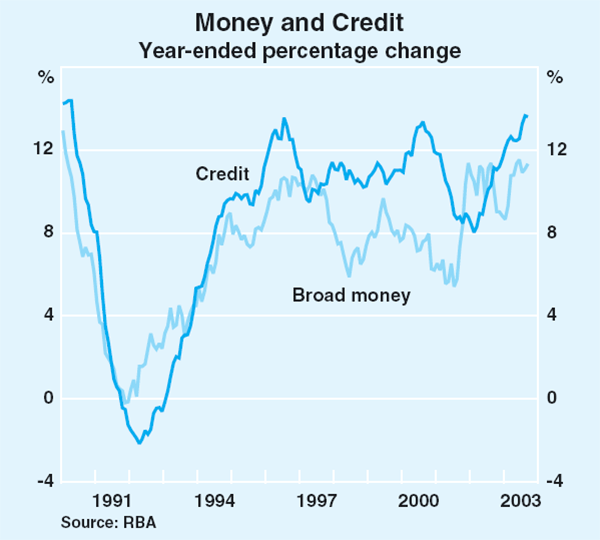
Equity raisings
Aggregate equity raisings in the September quarter were in line with average issuance of the past few years, with net issuance totalling $4 billion. While raisings by non-financial companies have recently been below past years' averages, raisings by financial companies have been particularly strong. Secondary raisings dominated, especially placements by non-financial companies and financial companies' raisings through dividend reinvestment plans. There was very little capital raised through new listings.
Box B: Comparing Australian and US Equity Returns
Since 1997, equity prices in both Australia and the US have risen by around 40 per cent (Graph B1). Movements in equity prices, however, provide only a partial measure of returns; a comparison of total returns requires also that dividends be taken into account. From the point of view of someone investing in both markets, exchange rate movements also need to be taken into account. This box attempts to quantify these considerations.
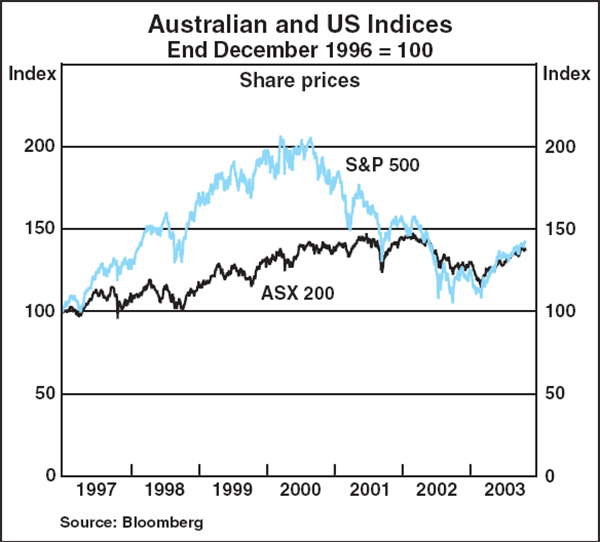
Price indices measure the capital gain or loss from holding a portfolio of shares. In the period to 2000, US share prices rose much more strongly than those in Australia; at their peak they were about double their level in 1997, whereas in Australia the peak level was one and a half times the 1997 level. Over the subsequent three years, however, US share prices fell sharply and the net increase since 1997 is now about the same in both countries.
Aside from movements in share prices, investors also receive returns in the form of dividends. Indices of the total returns on equities, known as ‘accumulation indices’, are calculated by taking account of dividends. Since 1997, dividend yields on the ASX 200 have averaged 3.6 per cent. On the S&P 500 they have averaged 1.5 per cent, with yields falling to around 1 per cent around the time of the peak in US share prices in 2000. Because of the higher dividend returns in Australia, the ASX 200 accumulation index has outperformed the S&P 500 accumulation index by 15 percentage points since 1997 (Graph B2).[1]
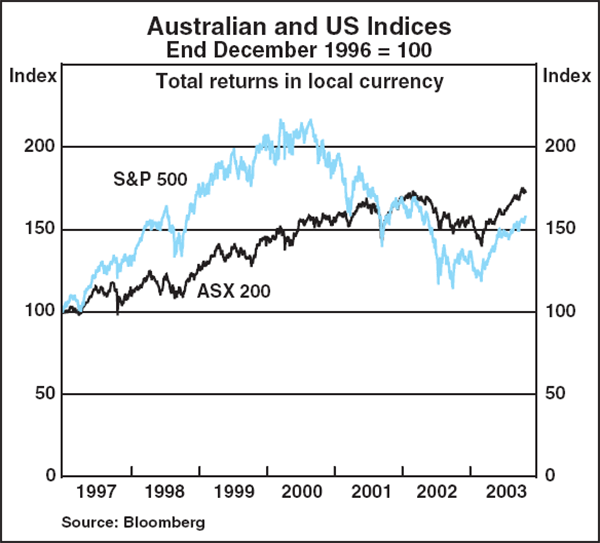
Exchange rate changes between the Australian dollar and US dollar have broadly offset this gap. Assuming that investors did not hedge their exchange rate risk, the Australian dollar value of their US investments can be calculated by converting the US accumulation index into Australian dollars at the prevailing exchange rate. Doing so suggests that investing in the domestic share market was broadly similar to investing overseas over this period (Graph B3).
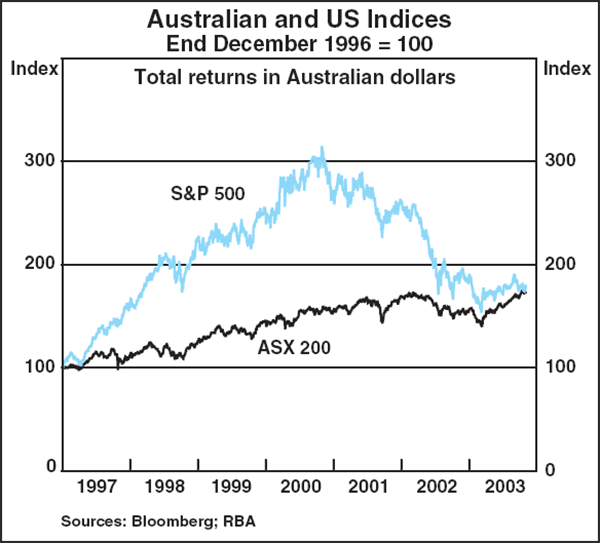
Finally, comparisons of equity markets' performance should also take account of differences in risk. Due to the lower price volatility of the Australian market during the past seven years, whether measured on local-currency or common-currency terms, the Australian market has outperformed the US market on a risk-adjusted basis.
Assessment of Financial Conditions
Financial conditions in Australia have been expansionary for some time. This has been most evident in the continuing rapid rate of credit expansion and the below-average level of interest rates.
At its November meeting, the Reserve Bank Board judged that it was appropriate to tighten financial conditions. As a result, the target cash rate was increased by 25 basis points to 5.0 per cent, having been unchanged since June 2002 (Graph 64).
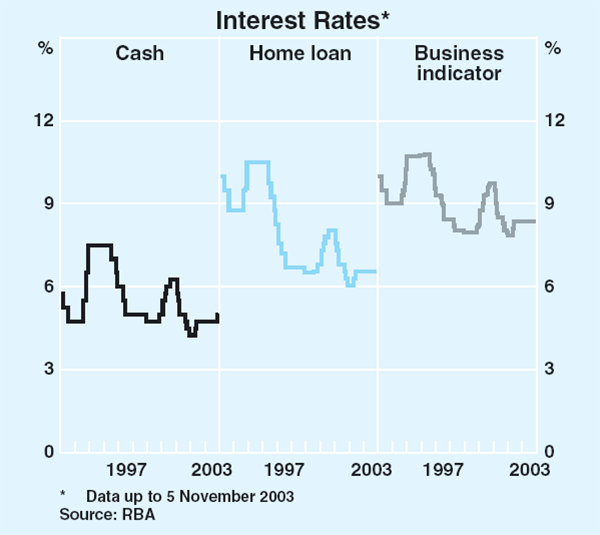
Following the increase in the cash rate, a number of smaller lenders announced increases in their variable lending rates, though, at the time of writing, most large lenders had not adjusted rates. Notwithstanding the increases seen, variable lending rates remain low by historical standards. Fixed lending rates on housing and business loans have also risen over recent months in response to higher bond yields, although they too remain below the average of the past decade.
Real interest rates also remain low by historical standards, given that most measures of inflation expectations have been relatively stable over recent years. Another indicator of financial conditions is the slope of the yield curve, as measured by the spread between the yield on 10-year bonds and the target cash rate. This spread is slightly higher than it was at the time of the previous Statement, though still below its average since the mid 1990s (Graph 65).
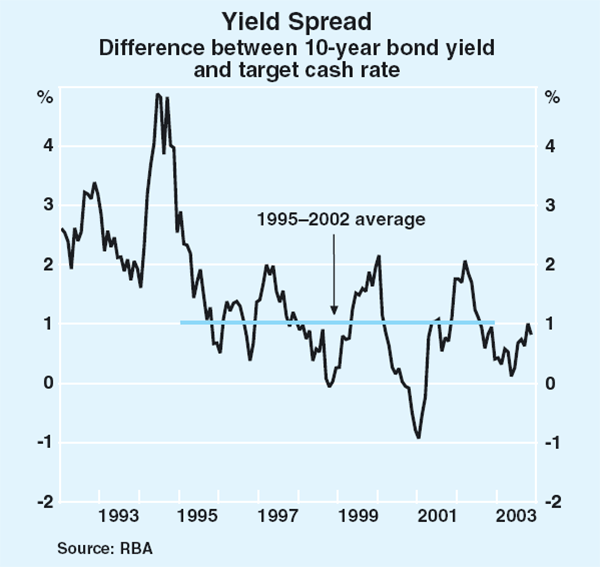
As discussed in the chapter on ‘Domestic Financial Markets’, credit has continued to grow strongly, increasing by 4.4 per cent over the past three months and by 13.6 per cent over the past year. The strong growth reflects a rapid increase in borrowing by the household sector, most of it in the form of housing credit. Looking forward, there is little evidence to suggest that the rate of credit growth is likely to slow in the near term, with new loan approvals for housing having increased by 24 per cent over the six months to August. Financial institutions continue to compete aggressively for housing loans and there is a steady stream of innovative and more flexible loan products being introduced to the market. Despite some financial institutions having reportedly tightened their credit standards for loans to investors in inner-city apartments, housing credit remains readily available to both investors and owner-occupiers.
The strong growth in housing credit over recent years has been associated with rapid increases in housing prices. The resulting improvement in balance sheets of existing owners has added to the generally favourable financial conditions experienced by many households. As discussed in the chapter on ‘Domestic Economic Conditions’, the wealth effects associated with rising housing prices have supported domestic consumption.
As was noted in the previous Statement, the current pace of household credit growth in Australia is high, relative to both the past and the experience of most other developed economies. Annual growth in household credit in Australia has exceeded growth in nominal GDP by an average of 8½ percentage points since the mid 1990s and currently exceeds nominal GDP growth by around 15 percentage points (Graph 66).
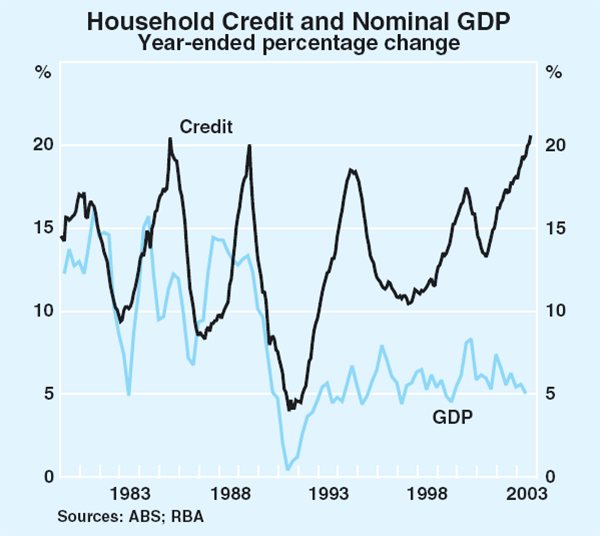
For businesses, financial conditions also continue to be quite favourable. Reflecting improved prospects for the global economy and ongoing strength in the domestic economy, the ASX 200 has increased by around 20 per cent from its mid-March trough. Business credit growth has also picked up modestly over recent months, although with generally healthy profit growth, many firms are still able to rely on internal funding to finance expansion plans. Few firms report interest rates or access to finance as being significant constraints on investment. Corporate bond spreads have moved lower over the past six months to around five-year lows, suggesting that concerns over credit quality are not hampering access to external funding.
As discussed in the chapter on ‘International and Foreign Exchange Markets’, the Australian dollar has appreciated in trade-weighted terms by around 6 per cent over the past three months and 18 per cent over the year. This follows a period during which the real exchange rate was well below its average value for the post-float period (Graph 67). Other things equal, the appreciation represents a tightening of financial conditions for firms in the traded sector of the economy, but it has occurred against the backdrop of a steady rise in the terms of trade and, over recent months, a brighter outlook for the world economy.
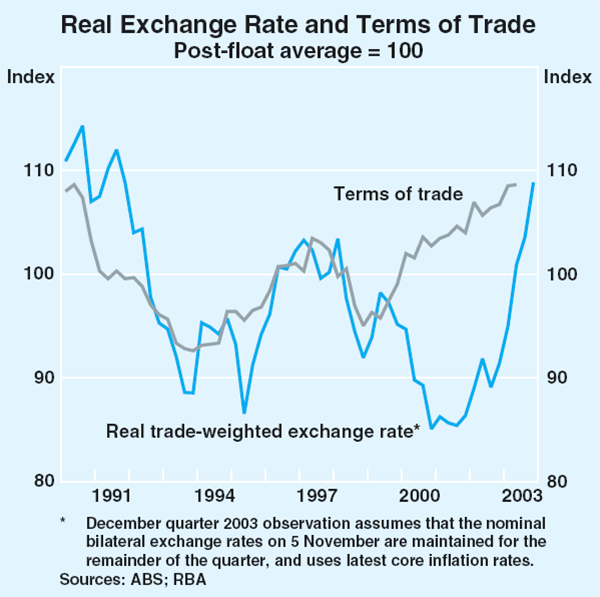
Inflation Trends and Prospects
Recent developments in inflation
Consumer prices
The Consumer Price Index (CPI) increased by 0.6 per cent in the September quarter to be 2.6 per cent higher over the year. This represents a small decline in year-ended inflation from the June quarter, and a more sizeable drop from an average inflation rate of around 3 per cent during 2002 (Graph 68). According to the various measures, underlying inflation was between 0.4 and 0.7 per cent in the September quarter (Table 14, Graph 69). Over the year, most measures show underlying inflation of around 2¾ per cent, with the main exception being the market goods and services excluding volatile items measure, which shows underlying inflation of 2 per cent. Overall, the Bank's assessment remains that, in year-ended terms, underlying inflation is running at around 2¾ per cent.

| Quarterly | Year-ended | ||||
|---|---|---|---|---|---|
| June quarter 2003 | September quarter 2003 |
June quarter 2003 | September quarter 2003 |
||
| CPI | 0.0 | 0.6 | 2.7 | 2.6 | |
| – Tradables | −0.9 | −0.3 | 1.0 | 0.7 | |
| – Tradables (ex petrol and food) | 0.3 | −0.5 | 0.6 | 0.2 | |
| – Non-tradables | 0.7 | 1.3 | 4.1 | 4.1 | |
| Underlying inflation | |||||
| Weighted median(a) | 0.5 | 0.7 | 2.9 | 2.7 | |
| Trimmed mean(a) | 0.5 | 0.6 | 2.6 | 2.6 | |
| CPI excluding volatile items | 0.6 | 0.6 | 2.7 | 2.6 | |
| Market goods and services excluding volatile items | 0.5 | 0.4 | 2.0 | 2.0 | |
|
(a) For more information on these measures see ‘Box D: Underlying Inflation’ in the May 2002 Statement on Monetary Policy. Sources: ABS; RBA |
|||||
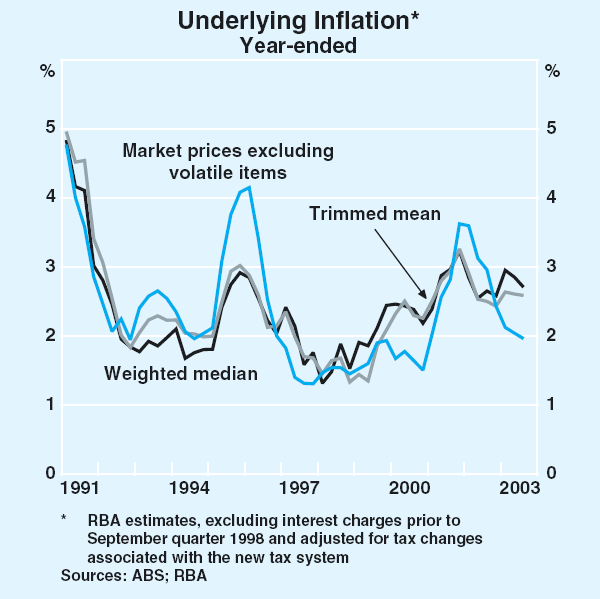
Movements in the exchange rate have had an important influence on inflation outcomes recently, as they have over recent years. In particular, the rise in consumer price inflation through 2000 to 2002 was partly driven by higher traded-goods prices following the 25 per cent depreciation in the nominal trade-weighted exchange rate between early 1998 and late 2001. More recently, the lower inflation outcomes largely reflect the 33 per cent appreciation of the Australian dollar since late 2001. This appreciation contributed to a 0.5 per cent fall in prices of tradables (excluding volatile items) in the September quarter; over the year, prices of tradables were broadly unchanged (Graph 70).
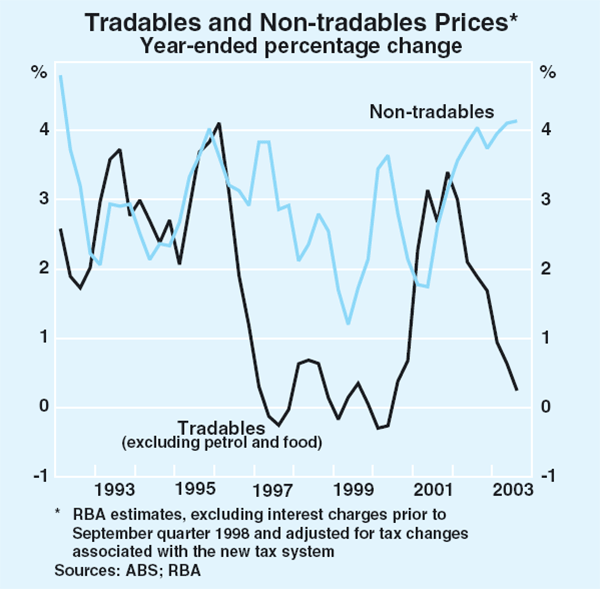
In contrast, the prices of non-tradables have increased strongly over the past year, rising by 4.1 per cent. This rise reflects considerable upward pressure on housing-related prices and the prices of a number of non-market goods and services.
Over the year to the September quarter, the housing component of the CPI increased by 4.6 per cent. This was underpinned by a 6.1 per cent rise in house-purchase costs, although many of the ongoing costs related to housing also grew strongly. The price of utilities and property rates and charges, for example, both increased by more than 5 per cent over the year. Running against this trend of large increases in housing-related prices, the increase in average rents has been quite modest, reflecting higher vacancy rates in many markets.
Strong price pressures are also evident in health and education services, with the price of health services rising by around 8 per cent over the past year and the price of education services by just under 5 per cent. While, in trend terms, the prices of these services tend to increase more quickly than the overall CPI, the recent outcomes partly reflect the relatively high wage increases in these sectors over the past year.
Looking in more detail at the September quarter, the removal of the Ansett Levy, as well as falling prices for international travel contributed to a 1.8 per cent fall in the price of holiday travel and accommodation. Food prices also fell (by 0.3 per cent) as the impact of the drought began to subside. The trend decline in audio, visual and computing equipment continued in the September quarter, with prices falling a further 7.3 per cent to be 20.8 per cent lower over the year. While the magnitude of this fall partly reflects the appreciation of the currency, it also reflects ongoing price declines associated with global overproduction and high productivity growth continuing in this sector.
Working in the other direction, there were sizeable rises in motoring charges and urban transport fares in the September quarter, as well as in alcohol and tobacco prices, due in part to the bi-annual excise indexation. Fuel prices were also up 3 per cent in the quarter, after having fallen by 9.6 per cent in the June quarter.
Producer prices
As with consumer prices, the exchange rate has been an important influence on producer prices recently. Over the past year, the prices of imported producer goods at all stages of production have fallen sharply, with prices continuing to fall in the September quarter. At the same time, however, significant upward pressures are evident in producer prices for domestically produced goods. This is most apparent at the final stage of production, where prices increased by 1.3 per cent in the September quarter to be up 4.3 per cent over the year, due in large part to higher prices for housing-related items and higher utilities charges. Reflecting these two contrasting sets of influences, overall final goods prices rose by 0.5 per cent in the September quarter, and by 1.5 per cent over the year (Table 15, Graph 71). Indicators of upstream inflationary pressures from business surveys remain generally subdued, reflecting the dampening effect of the exchange rate appreciation.
| September quarter 2003 |
Year to September quarter 2003 |
Year to June quarter 2003 |
||
|---|---|---|---|---|
| Preliminary | −0.4 | 0.6 | 1.3 | |
| – Domestic | 0.0 | 2.1 | 2.3 | |
| – Imported | −3.6 | −8.5 | −4.3 | |
| – Excluding oil | −0.2 | 1.1 | 1.5 | |
| Intermediate | −0.4 | 0.8 | 1.3 | |
| – Domestic | 0.1 | 2.6 | 2.5 | |
| – Imported | −3.6 | −9.4 | −5.2 | |
| – Excluding oil | −0.3 | 1.0 | 1.4 | |
| Final | 0.5 | 1.5 | 1.4 | |
| – Domestic | 1.3 | 4.3 | 3.5 | |
| – Imported | −3.2 | −10.5 | −7.4 | |
| – Excluding oil | 0.4 | 1.4 | 1.5 | |
|
Source: ABS |
||||
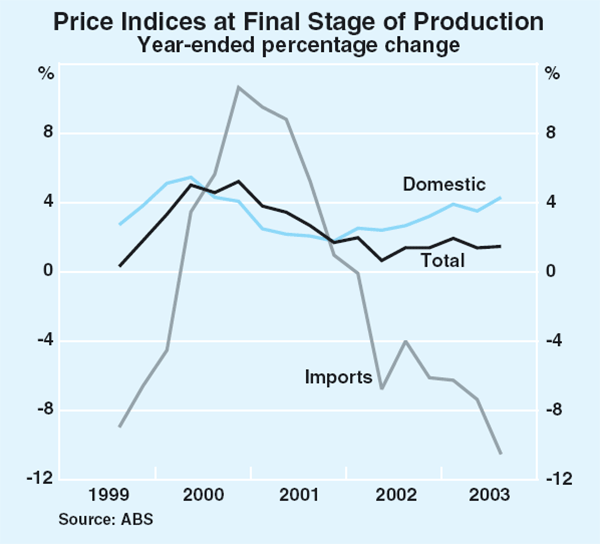
Labour costs
Most measures of wages show that growth continued at a firm pace over the first half of 2003. This is consistent with other indicators pointing to relatively tight conditions in the labour market (as discussed in the chapter on ‘Domestic Economic Conditions’). In addition to the relatively low unemployment rate, business surveys suggest that firms are finding it increasingly difficult to find suitable labour.
In the June quarter, the wage cost index (WCI) for total pay increased by 0.8 per cent in seasonally adjusted terms, to be 3.5 per cent higher over the year, compared with an increase of 3.6 per cent over the year to March 2003 (Graph 72). Data from the Department of Employment and Workplace Relations (DEWR) suggest that average wage growth certified in new federal enterprise bargaining agreements (EBAs) was around 4 per cent over the first half of 2003, similar to the growth rate over the second half of 2002. Unit labour costs (based on compensation per hour worked) grew by 1.3 per cent in the June quarter to be 2.8 per cent higher over the year, which is around the average growth rate of the past few years. The WCI suggests that the education sector experienced the largest wage increases over the year to the June quarter 2003, while the smallest gains were in the communications sector. Despite signs of emerging labour shortages, the WCI records that wage increases in the construction industry over the past year were only marginally above the all-industry average. Nonetheless, builders are reporting significant cost pressures in the construction sector, driven by increased payments to subcontractors (which are not covered by the WCI).
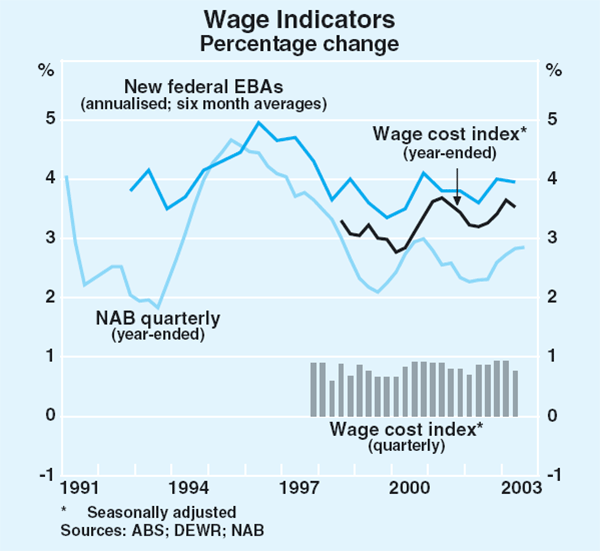
Preliminary indications are that wages growth remained firm in the September quarter. The NAB survey suggested that growth over the year to the September quarter was similar to that seen over the year to June, while the latest Mercer Quarterly Salary Review suggests that growth in executives' base salaries picked up marginally to 4.5 per cent over the year to the September quarter.
Inflation expectations
Measures of inflation expectations have been relatively stable for some time (Graph 73). The Melbourne Institute survey suggests that consumers' inflation expectations remain around their average for the inflation-targeting period. In line with this, the NAB survey reported that firms continue to anticipate low and steady inflation for final product and retail prices, both of which are expected to increase by 0.3 per cent in the December quarter.

Investors' expectations of inflation over longer horizons – as measured by the difference between the yield on 10-year nominal and indexed bonds – have fluctuated in a narrow range of between 2 and 2½ per cent over recent years. The Bank's quarterly survey of financial market economists suggests that near-term inflation expectations have changed little over recent months, with the median forecast for inflation over the year to June 2004 at 2.2 per cent in November, compared with 2.3 per cent in August. However, while inflation is expected to moderate from current levels in the short term, it is widely expected to pick up a little in 2005, with the median forecast for inflation in the year to June 2005 stable over recent quarters at 2.5 per cent (Table 16). Trade union officials surveyed by the Australian Centre for Industrial Relations Research and Training (ACIRRT) still expect inflation to be 3.0 per cent over the year to mid 2004. Over the year to mid 2005, they expect inflation of 3.2 per cent, which is up slightly from their August projection.
| Year to June 2004 | Year to June 2005 | |||||
|---|---|---|---|---|---|---|
| May 2003 | August 2003 | Nov 2003 | August 2003 | Nov 2003 | ||
| Market economists(a) | 2.3 | 2.3 | 2.2 | 2.5 | 2.5 | |
| Union officials(b) | 3.5 | 3.0 | 3.0 | 3.0 | 3.2 | |
|
(a) RBA survey (b) ACIRRT survey |
||||||
Inflation outlook
As indicated above, the Bank's assessment is that underlying inflation in the year to the September quarter was around 2¾ per cent, the same as in the past two quarters. At the time of the previous Statement the Bank judged that year-ended underlying inflation was likely to fall to around 2 per cent in the first half of 2004, reflecting the appreciation of the Australian dollar, before edging up over 2005. Since that time, the key developments have been a further appreciation of the currency and stronger-than-expected growth in domestic demand. The net effect of these factors is that, compared with earlier expectations, year-ended underlying inflation may now trough somewhat lower, while the pick-up in inflation into 2005 is now likely to be more pronounced, with underlying inflation expected to be back at around 2½ per cent by the second half of the year (assuming no further change in the exchange rate).
Year-ended CPI inflation is expected to be marginally below underlying inflation for much of 2004. This largely reflects the large March 2003 CPI figure dropping out of the year-ended calculation, as well as the Bank's standard assumption that international oil prices will fall to the middle of the OPEC target band within about a year. As these effects abate in the first half of 2005, CPI and underlying inflation are expected to become more closely aligned.
As has been the case for some time, the main source of downside risk to the inflation forecast is associated with the international economic climate. If the current global recovery were to lose momentum, it would mean a less favourable environment for growth of the Australian economy, and thus lower inflation outcomes in the medium term. However, as discussed elsewhere in this Statement, the risk of significant under-performance of the global economy has lessened considerably over recent months. Another source of downside risk is the possibility of a further appreciation of the exchange rate. However, if that were to occur in the context of generally strengthening economic conditions in Australia and abroad, there would be offsetting upward pressures from strong demand. On the upside, there is a risk that the pass-through of recent exchange rate changes into retail prices will be less than currently anticipated, if retailers take advantage of strong domestic demand to increase profit margins. This would mean that the decline in inflation in the short term would be less than currently expected. There is also a longer-term risk that domestic cost pressures build further, given the strong momentum of domestic demand.
Footnote
Portfolio credit-linked notes are debt securities that package together a standard corporate bond with a credit default swap. They are designed to mimic the risk and return characteristics of a collateralised debt obligation. [1]
Footnotes Box B
These calculations do not take into account the various taxes on such investments in the two countries. [1]